This incredible itinerary for India’s north-west will take you on an unforgettable Rajasthan road trip, plus Delhi, Agra and more.
Nothing quite prepares you for the pure assault on the senses, the kaleidoscopic chaos and irrepressible humanity of India.
A country of 1.4 billion people, many thousands of temples, and around five million roaming cows, India is quite simply, like nowhere else on earth.
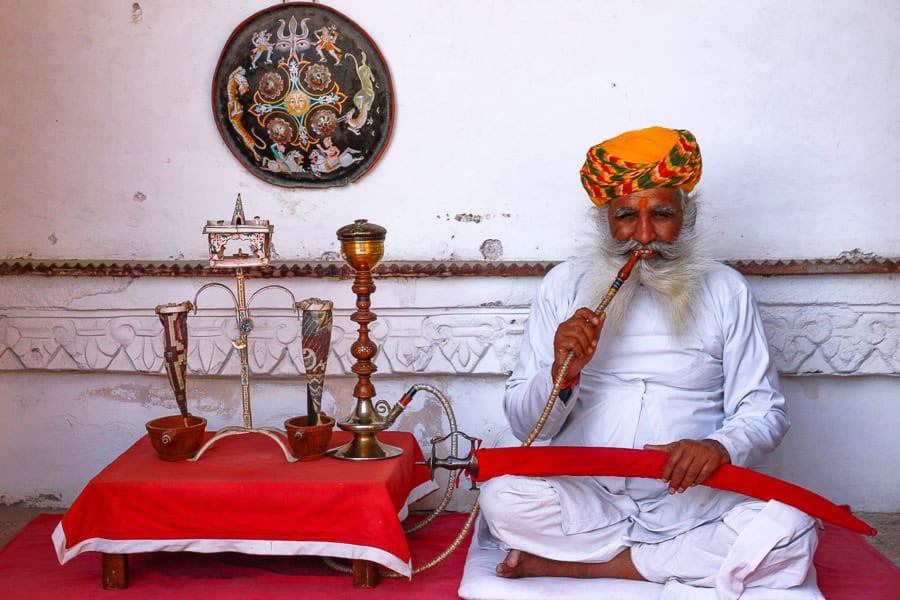
It’s a country you experience through the senses in a way that rarely sees you in the same postcode as your comfort zone. But it’s also that overwhelming fusion of people, culture, cuisine, religion, and history that makes India so alluring.
You can’t visit Rajasthan without being captivated by its diverse and incredibly rich array of cultural treasures.
Whether it’s milling with hundreds of Muslim pilgrims at the shrine of a Sufi saint at Ajmer; being chased by macaques at the Hindu Galwar Bagh Monkey Temple in Jaipur; tiptoeing around thousands of pampered holy rats at the Hindu Karni Mata Temple near Bikaner; or wandering through the exquisitely carved, milky-marble magnificence of the Jain Chaumukha Mandir Temple in Ranakpur; Rajasthan’s cultural riches will blow your mind.
And if all that history and culture isn’t enough, Rajasthan will tantalise your tastebuds in a way few places can.
We’ve got fond memories of eating spicy aloo chat from smiling street vendors, enjoying tasty parathas at every possible opportunity, and scoffing consistently delicious vegetarian curries just about everywhere. And let’s not forget the ubiquitous, impossibly sweet, yet almost impossible to resist jalebi desert . . . YUM!!
Rajasthan Road Trip Itinerary – Snapshot
Start: Delhi
Finish: Delhi or Varanasi
Distance: appx. 2,600km (1,600 miles) finishing in Deli, or 3,100km (1,950 miles) finishing in Varanasi.
How long do I need? You’ll need 3 to 4 weeks for this north-west India Itinerary, which takes in some of the country’s most iconic cities and landmarks on an epic Rajasthan road trip.
Overnight stops: 2-3 nights in Delhi, 2 nights in Jaipur, 1 night in Pushkar, 2 nights in Bikaner, 3 nights in Jaisalmer, 2 nights in Jodhpur, 1 night in Kumbhalgarh, 3 nights in Udaipur, 1 night in Bundi, 2 nights in Ranthambore, 1 night in Bharatpur, 2 nights in Agra, then either head back to Delhi to finish, or continue on to Varanasi via Orchha and Khajuraho (an additional 5-7 days).
Rajastahn Road Trip Itinerary
What’s the route
Planning a Rajasthan Road Trip
– How long do I need for this Rajasthan itinerary?
– Best time to visit Rajasthan
– Travel to Rajasthan
– Deciding between public transport and a road trip in Rajasthan
– Accommodation in Rajasthan
Rajasthan Road Trip Itinerary
– Pre-road trip: getting started in Delhi
– Leg 1: Delhi to Jaipur
– Leg 2: Jaipur to Pushkar via Ajmer
– Leg 3: Pushkar to Bikaner
– Leg 4: Bikaner to Jaisalmer
– Leg 5: Jaisalmer to Jodhpur
– Leg 6: Jodphur to Kumbhalgarh via Ranakpur
– Leg 7: Kumbhalgarh to Udaipur
– Leg 8: Udaipur to Bundi via Chittorgarh
– Leg 9: Bundi to Ranthambore
– Leg 10: Ranthambore to Bharatpur
– Leg 11: Bharatpur to Agra
– Final Leg (Option 1): Agra to Delhi via Fatehpur Sikri
– Final Leg (Option 2): Extend your road trip to Varanasi
This post contains affiliate links. If you choose to buy through these links we may earn a small commission at no extra cost to you, which helps us to keep Two for the World running. Many thanks for your support!
What’s the Route?
Often the focal point of Indian tourism, Rajasthan and its surrounds are home to some of the cultural and architectural highlights of India, if not the world.
The state of Rajasthan – literally ‘Land of the Kings’ – has some of the most incredible forts in the region. These mighty edifices, rising above cities or out of the desert landscape like giant, abstract mountains of stone, often left us lost for words, and fast running out of memory on our SD cards.
This itinerary for India’s north-west takes in some of the country’s most iconic cities and landmarks over an incredible 3 to 4 week Rajasthan road trip, covering more than 2,600km.
You’ll start with a couple of days exploring the many historical sites of Delhi, before getting on the road to Jaipur for a couple of nights to visit the Amber Fort, the City Palace and Hawa Mahal.
Heading west, the sacred lake and Brahma Temple of Pushkar beckon, followed by a couple of nights in Bikaner, home to Junagarh Fort and the Karni Mata Rat Temple at Deshnok. The trip continues on to the desert city of Jaisalmer, with its incredible sandstone fort, beautiful havelis, and safaris into the nearby Thar Desert.
You’ll see the mighty Mehrangarh Fort in Jodhpur and the old city’s famous blue houses, before travelling to Kumbhalgarh for a night to see its massive fort walls. The lakeside city of Udaipur makes the perfect spot to slow down for a couple of days as you enjoy its lakes, palaces and local markets.
On the return leg, there’s tiger spotting to be had at Ranthambore National Park and incredible birdwatching in Bharatpur before you arrive in Agra for a visit to the iconic Taj Mahal.
The final leg takes you back to Delhi via Fatepur Sikri, the ancient capital of the Mughal empire. Or, if you have more time, all the way to holy city of Varanasi via the intricately carved temples of Khajuraho.
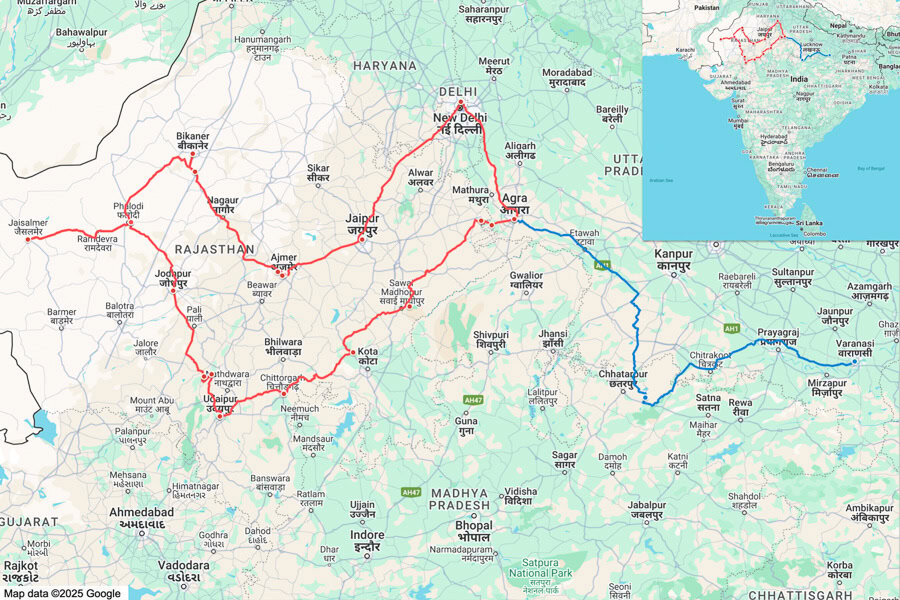
Planning a Rajasthan Road Trip
How long do I need for this Rajasthan itinerary?
To get the most out of a road trip in Rajasthan, you’ll need at least 10 to 14 days. This gives you enough time to visit the key cities – Jaipur, Jodhpur, Udaipur, Jaisalmer and Bikaner – without feeling rushed. It also allows for travel time between destinations, which can be deceptive: unexpected roadworks, congestion, even cows on the road can all slow you down.
If you’re short on time, you can cover Rajasthan’s main cities in a week. A typical 7-day route includes Jaipur, Jodhpur and Udaipur. These cities are well connected by road and offer a good mix of forts, palaces, lakes and markets.
For a more in-depth road trip in Rajasthan like the one described here, you’ll need at least three weeks, and more like four weeks if you want to include Varanasi.
This gives you time to visit all the key places to visit in Rajasthan, along with some of the less-visited places like Bundi, Chittorgarh, and the desert areas around Jaisalmer. You’ll also have the flexibility to take things at a slightly slower (but by no means slow) pace, and add on activities like a desert safari, birdwatching in Keoladeo National Park, or wildlife spotting in Ranthambore National Park.
Keep in mind that Rajasthan is a large state, and travel between cities often takes 4 to 6 hours by road. Planning enough time means you can enjoy the journey and avoid cramming too much into each day.
Best time to visit Rajasthan
The best time to visit Rajasthan is between October and March. During these months, the weather is cooler and more comfortable for travelling long distances by road.
Daytime temperatures are mild, making it easier to explore cities, forts and desert areas without the extreme heat that Rajasthan is known for in the summer. It is, however, peak season so you can expect higher prices and more fellow tourists.
Between April and June, temperatures can rise above 40°C, making travel uncomfortable and sightseeing a challenge. Summer is understandably low season in India, so you may benefit from lower prices and fewer tourists (if you can stand the heat).
The monsoon season, from July to September, brings some relief from the heat but also unpredictable rain, which can disrupt travel plans, particularly in rural areas. Monsoon and summer are both times of year we tend to steer clear of.
Travel to Rajasthan
Getting to Rajasthan is straightforward, with several options depending on where you’re starting from. For international travellers, the most convenient entry points are Delhi and Mumbai. Both cities have major international airports with direct flights from Europe, North America, the Middle East and Asia.
Jaipur International Airport also handles some direct international flights from destinations like Dubai, Kuala Lumpur and Bangkok.
Domestically, Rajasthan is well connected with other major Indian cities by air, including Jaipur, Udaipur, Jodhpur and Jaisalmer, with airlines such as IndiGo, Air India and Vistara offering regular services.
Rajasthan is also accessible by domestic train services. Indian Railways operates regular services from Delhi, Mumbai and other cities to Jaipur, Jodhpur, Udaipur, Bikaner and Jaisalmer. Trains are a good option if you prefer a more relaxed journey.
Travel to Rajasthan by long-distance buses from neighbouring states is possible, but they are generally slower and less comfortable for long journeys compared to flights or trains.
Stay connected in India
While we were in India we managed to get online with the assistance of our driver who helped us buy and connect a local SIM card. Even then the process took a while and was a little painful.
If you’d prefer to have your internet access sorted before you arrive you might want to consider getting online in India using an international eSIM like Yesim.
Having access to mobile data is certainly helpful for navigating your way around India’s frenetic cities and towns, along with staying connected with the news and being able to book hotels and tours on the go.
Deciding between public transport and a road trip in Rajasthan
When it comes to developing a Rajasthan itinerary, you’ll eventually arrive at the dilemma we had, which was deciding between travelling Rajasthan by road or public transport.
There are definitely pros and cons with each. It really comes down to what you want to see, how you want to see it, the length of time you have, your budget, and how flexible you can afford to be.
Our Rajasthan travels were in December, and having heard a few stories of travellers being stuck in places for days due to fog-cancelled trains and other mishaps, we decided we would get more out of our itinerary for India’s northwest with a car and driver.
While this inevitably bumped up our daily budget, it really did turn out to be a good call, giving us the flexibility to explore more Rajasthan highlights, including its amazing forts, palaces and temples, as well as seeing some wonderful countryside and dozens of small bustling villages we might have missed if we travelled by train or bus.
If you do decide on an India road trip like we did, it’s still worth making time in your Rajasthan itinerary for a train journey at some point if you can. Travelling India’s iconic railways is a fantastic way of getting to know India, and the interactions you have with local people on train journeys may be some of your most memorable experiences.
Our own Rajasthan road trip took place over three weeks, so if you follow the route below as it rolls out, you can expect to spend around the same amount of time on the road.
However, we’ve also taken the approach of capturing the highlights of each leg, so you can create your own itinerary with the time and opportunity you have.
To that end, we’ve also included rough distances and travel times between destinations. Let’s be clear though, this is India, and the amount of time it takes to get from one place to another can be affected by any number of things on the day: nature, weather, traffic, humans, cows on the road. Take the timings as a guide, but as with all road trips, factor in extra time and contingencies just in case.
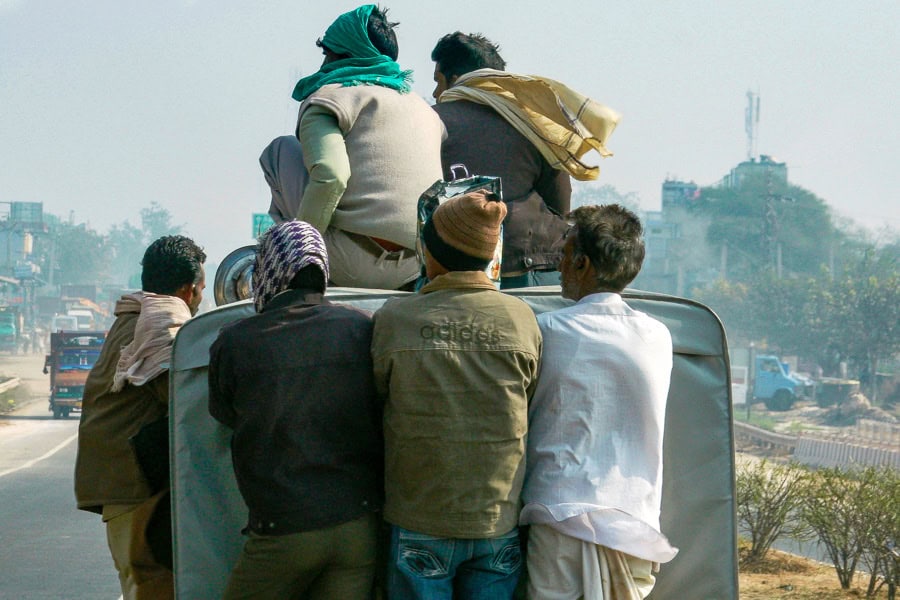
Accommodation in Rajasthan
Rajasthan offers a wide range of accommodation options to suit different budgets and travel styles. You’ll find everything from luxury heritage hotels to simple guesthouses and budget stays.
Many of Rajasthan’s top hotels are converted palaces and havelis (historic houses, often beautifully carved and decorated), offering a glimpse of the state’s royal history. Cities like Jaipur, Udaipur and Jodhpur have well-known heritage properties, where you can stay in historic buildings with courtyards, traditional décor, and modern comforts. These often include amenities like swimming pools, on-site restaurants, and guided tours.
For mid-range travellers, there are plenty of boutique hotels and smaller heritage stays. These usually offer comfortable rooms, good locations, and a more personal atmosphere. Homestays are also an option, particularly in rural areas and smaller towns, where you can experience local life and home-cooked food.
Budget accommodation in Rajasthan’s major cities and along popular routes is widely available. Hostels, guesthouses, and budget hotels provide basic facilities and are ideal if you’re on a tighter budget.
It’s a good idea to book in advance, especially if you’re travelling between October and March, when Rajasthan’s tourist season is at its peak. Prices tend to rise during this period, and popular places can fill up quickly.
Rajasthan Road Trip Itinerary
Pre-road trip: getting started in Delhi
Highlights: Red Fort | Jama Masjid Mosque | Tomb of Humayun | Agrasen ki baoli
Total driving distance: appx. No driving in Delhi – you’ll get on the road in a few days time.
Overnight: Delhi (2-3 nights)
Like many visitors, we started our India itinerary in the country’s capital, Delhi. When you get past the inevitable culture shock that comes with landing in a city of more than 34 million souls – especially when it feels like all those souls are talking, yelling, laughing, and honking their horns at the same time – you’ll begin to understand just what India is.
While Delhi can be completely overwhelming for the first time visitor, once you get used to the pace, the noise, the traffic, the smells, and the sheer number of people, you’ll discover a city bursting at the seams with colour, culture and a ton of things to see and do.
It’s almost impossible to pick highlights, but there’s something about the 17th-century Red Fort, with its immense sandstone walls, elaborate pavilions, and peaceful gardens, that always draws us back when we visit Delhi.
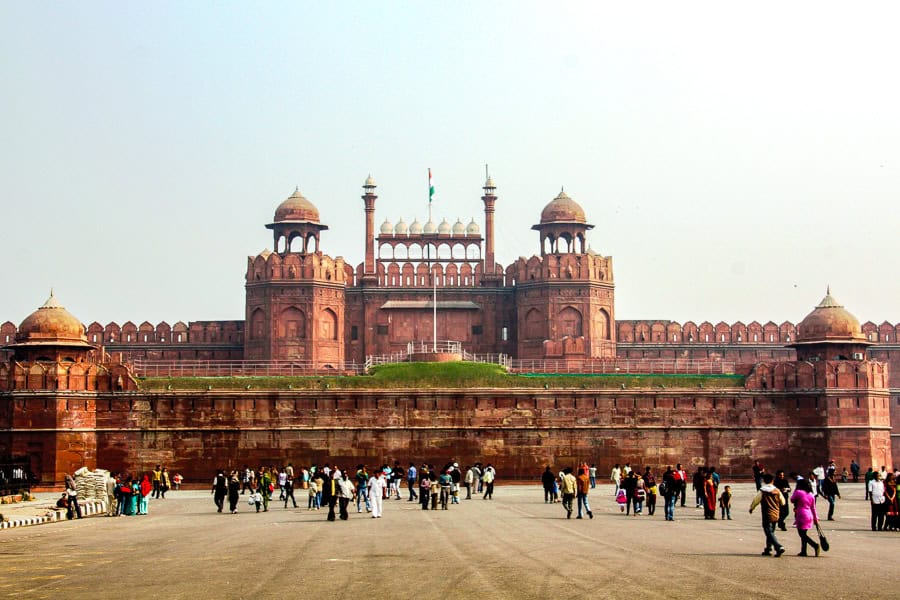
An early morning wander through the intricately chiselled hallways and huge courtyard of Delhi’s 360-year-old Jama Masjid Mosque is also pretty high on our list of the best things to do in Delhi.
And if you’re World Heritage fans like us, southern Delhi’s Tomb of Humayun, thought to be the inspiration behind the Taj Mahal, is a delight.
For something a little different, be sure to also seek out one of Delhi’s remaining baolis, or stepwells. Our favourite, the 14th-century Agrasen ki baoli, is an easy walk from Connaught Place. Exploring this three tiered, 104 step masterpiece makes for a peaceful escape within the busy city, and is well worth making the effort to visit.
Our North India tour by car kicks off tomorrow, so if you’re following this itinerary, arrange for your driver to collect you first thing in the morning.
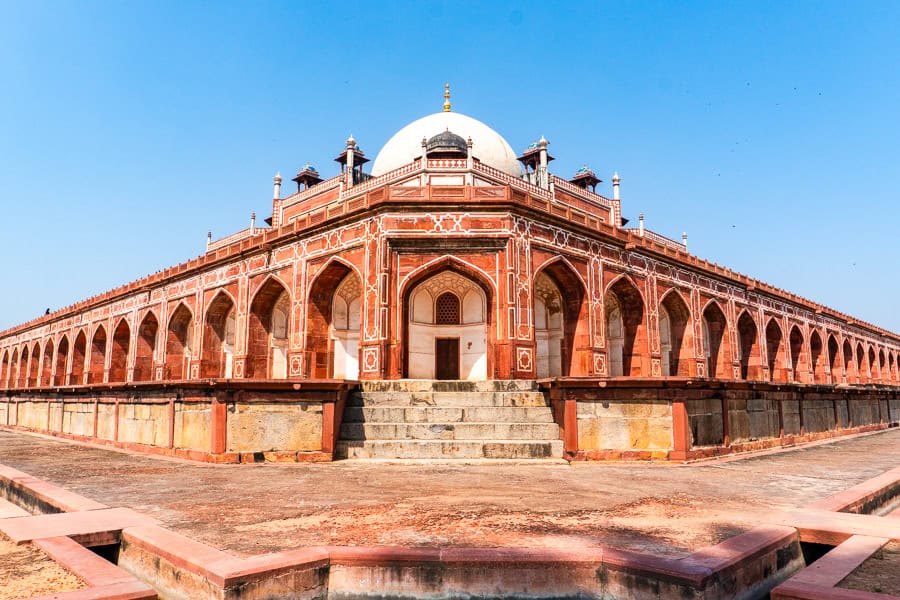
Delhi guided tours
If you want a slightly more immersive experience in Delhi you may want to consider a guided tour. There are a multitude of options available in this space, covering everything from architecture, to culture, religion and food.
The following popular tours get great reviews from other travellers and offer secure booking and free cancellation:
- Old and New Delhi Private Full or Half-Day Tour: This flexible private tour explores Delhi’s iconic landmarks including Jama Masjid, Chandni Chowk, Gurudwara Bangla Sahib, the Lotus Temple, Humayun’s Tomb, Qutub Minar and more.
- Old Delhi Street Food Tour: Explore the bustling backstreets of Old Delhi to sample local favourites like chole bature, parathas, and jalebis from hand-picked street vendors. This 4 hour tour (with private and group options) includes a visit to Asia’s largest spice market, Chandni Chowk.
Where to stay in Delhi
India’s capital is a large, sprawling, heavily populated city where accommodation options range from very basic, budget guesthouses to some of the most luxurious hotels in the world – and pretty much everything in between.
Popular areas to stay include Connaught Place, close to shopping and restaurants, and Paharganj, known for budget hotels and hostels. South Delhi neighbourhoods like Hauz Khas and Greater Kailash offer mid-range boutique hotels and quieter surroundings. For high-end stays, areas near Chanakyapuri and Aerocity have five-star hotels with modern amenities.
We’ve stayed at a number of places in Delhi over the years. On our most recent visit, we stayed at Bloomrooms @ New Delhi Railway Station. Conveniently located near New Delhi’s main train station (a major hub), rooms are compact, modern and clean, and have a bit of an Ibis vibe happening. Our room had a balcony and decent air conditioning. Expect a bit of street noise – this is Delhi after all.
Dan has also stayed at the ITC Maurya in Chanakyapuri – it’s a great example of India’s upmarket hotel offering, with exceptional service and a price tag to match.
The following options also get consistently good reviews:
- Good value: Hotel Blue Pearl – Affordable, centrally located near New Delhi Railway Station with 24-hour front desk and helpful, attentive staff. The good-sized rooms are clean and comfortable, and breakfast and airport pickup are included.
- Mid-range: Casa Central – Simple, spacious and clean rooms with comfy beds, private bathrooms, air-con and soundproofing in the central Paharganj area – close to train and metro stations.
- Upmarket: Maidens Hotel New Delhi – If you want some colonial era luxury close to the centre of town and the metro, this might just suit. It’s not cheap, but the large, modern rooms have a colonial charm, enhanced by a peaceful setting and beautifully maintained gardens. Facilities include an outdoor pool, fitness centre, two restaurants, a bar and a tour desk.
Leg 1: Delhi to Jaipur
Highlights: Amber Fort | Jaigarh Fort | Wildlife SOS Rescue Centre | City Palace | Mantar Astronomical Observatory | Hawa Mahal
Total driving distance: appx. 275km (170 miles)
Total driving time: appx. 4.5 hours
Overnight: Jaipur (2 nights)
Our Rajasthan road trip is underway! The journey from Delhi to Jaipur is almost 280 kilometres and takes up to five hours, so settle in and enjoy your first glimpses of the countryside as you pass from Delhi, through the state of Haryana and into Rajasthan proper.
Exploring Jaipur, the Pink City
It’s handy having a car to explore the many sites in and around Jaipur. So even though it’s worth basing yourself here for a couple of days, you’ll definitely have use of the wheels.
My enduring memory of Jaipur is marvelling at the rocky mountainscape surrounding the Amber Fort (also called the Amer Fort), from the finely carved and multi-pillared audience hall. I can still distinctly remember a fresh breeze washing over me, taking some of the heat out of the day and causing me to linger and enjoy the moment.
You can get lost in the Amber Fort for hours, exploring marvellously designed and highly ornate gateways, courtyards, pavilions and temples. It’s a place where you’ll quite literally be dazzled by the intricately designed mirror tiles of the world renowned Sheesh Mahal, awed by opulent royal palaces, and wowed by incredible views on all sides.
One of those views looks up towards a ridgeline dominated by the many towers of Jaigarh Fort. With its imposing fortifications and incredible views over Amber Fort, which it was designed to protect, it’s definitely another unmissable stop on your Jaipur itinerary.
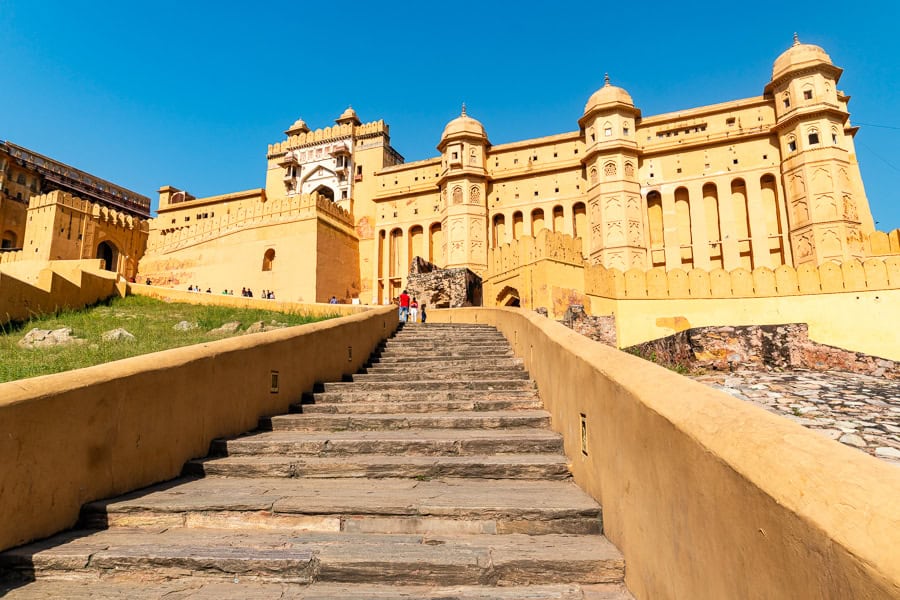
Take a walk, skip the elephant ride
The Amber Fort is reached by a wide, winding pathway up the mountainside. Jeeps run visitors up to the top, or you can take a slow stroll and stop for lots of pics along the way. You’ll also see elephants carting tourists up the path, and while this has long been considered a popular part of the fort experience, we ask you to think twice before joining the queue and #refusetoride.
Instead, consider visiting an elephant sanctuary like the Wildlife SOS rescue centre at Mathura near Agra. There, rescues – including elephants from Amber Fort – are given the care and freedom from chains they deserve. We’ve written in detail about the plight of working elephants in India in this story that we wrote for NOMADasaurus.
Back down at ground level, Jaipur has a multitude of other attractions that, depending on your pace, could easily take a few days to explore and fully appreciate. In the heart of Jaipur, the City Palace, with its many halls, courtyards and pavilions will leave you with a regal feeling, while UNESCO-listed Jantar Mantar astronomical observatory will help fix your place in both space and time.
Don’t leave without wandering by Hawa Mahal. It’s a place you’ll probably recognise even if you’ve never visited Jaipur, courtesy of it being the poster child for many a tourism campaign. This former royal retreat, all five stories and 900-plus windows of it, delightfully carved out of pink sandstone, is one of our favourite places to visit in Rajasthan, perhaps even India, and it’s a must-see.

Where to stay in Jaipur
Accommodation options in Jaipur range from budget guesthouses to luxury heritage hotels. Popular areas to stay include the Old City, close to major attractions like the City Palace and Hawa Mahal, and Bani Park, known for quieter, mid-range hotels.
MI Road offers good access to shopping and dining, while Amer has upscale resorts near Amber Fort. Mid-range hotels often feature heritage-style architecture and modern facilities, while more luxurious options offer pools and on-site dining. Budget travellers will find plenty of affordable guesthouses and hostels across the city.
The following options get consistently good reviews:
- Good value: Chillout – Boutique Hotel & Rooftop Restaurant – Well-located between the city centre and Amber Fort, this hotel has spacious rooms with air con. There’s a relaxed rooftop restaurant and common area with great views over the surrounding area.
- Mid-range: Hotel Arya Niwas – Renovated heritage hotel set in relaxing landscaped gardens just 2km from City Palace and Hawa Mahal. Rooms are clean and comfortable with decent air-con. There’s also a very good vegetarian café here.
- Spend a bit more: Dera Rawatsar Heritage Hotel – A heritage hotel offering air-conditioned rooms with private bathrooms and modern amenities, located 3km from City Palace and Hawa Mahal. Facilities include a swimming pool, fitness centre and a highly-rated restaurant.
We stayed at the Hotel Pearl Palace, a good-value place near the railway station and a short drive from major sights like the City Palace and Hawa Mahal. Our clean, comfortable room was a reasonable size with fan, AC and brightly coloured murals. The rooftop restaurant was an added bonus, serving up tasty breakfasts and dinners with a great view across the city – we would definitely recommend eating here!!
Leg 2: Jaipur to Pushkar via Ajmer
Highlights: Khwaja Muin-ud-din Chishti Shrine | Soni Ji Ki Nasiyaan Temple | Adhai-din-ka-jhonpra Mosque | Taragarh Fort | Pushkar Lake | Jagatpita Brahma Mandir Temple
Total driving distance: appx. 170km (100 miles)
Total driving time: appx. 3.5 hours
Overnight: Pushkar
The holy city of Ajmer
On the day we visited Ajmer, the sheer number of pilgrims jostling their way through the ornate main gate of the Khwaja Muin-ud-din Chishti shrine, the city’s most revered site, was simply mind boggling.
Once you’ve visited the shrine and extracted yourself from the crowds, it’s worth exploring the city’s smattering of Jain temples, including quirky Soni Ji Ki Nasiyaan with its 1000kg City of Gold.
We also recommend taking in the atmosphere of one of India’s oldest mosques, the 12th-century Adhai-din-ka-jhonpra, with its delicately carved inscriptions and pillars.
On the way out of town, be sure to head up to nearby Taragarh Fort for incredible views over Ajmer and Lake Ana Sagar before heading further towards the Thar Desert and our ultimate destination today, the town of Pushkar.
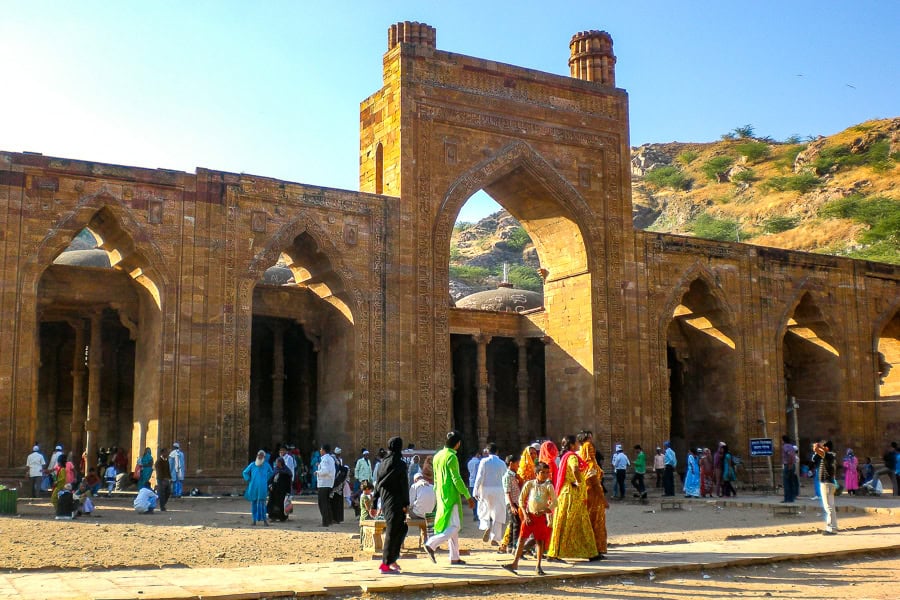
A pilgrimage to Pushkar
Centred around a sacred lake overlooked by Naga Pahar hill, Pushkar is quite literally the stuff of Hindu legend, making this ancient city – one of India’s oldest – an important and popular pilgrimage site.
Early morning is a great time to take a stroll around the lake before the heat of the day really kicks in. It’s worth grabbing a chai, finding a spot to sit, and watching the temples and ghats come to life as thousands of colourful pilgrims and other devotees bathe or perform their morning ritual or prayer.
Visitors are spoilt for choice in a city boasting many hundreds of temples. However no visit would be complete without a visit to one of India’s few Brahma temples, the 14th-century Jagatpita Brahma Mandir, perhaps the most famous and visited temple in Pushkar.
As you wander around the frenetic, colourful streets that wrap themselves around Pushkar’s sacred lake, you’ll almost certainly notice the intricately carved decorative gopuram (tower) of Old Rangji Temple. It’s another place worth visiting to appreciate the unique architecture and beautiful craftmanship of the building.
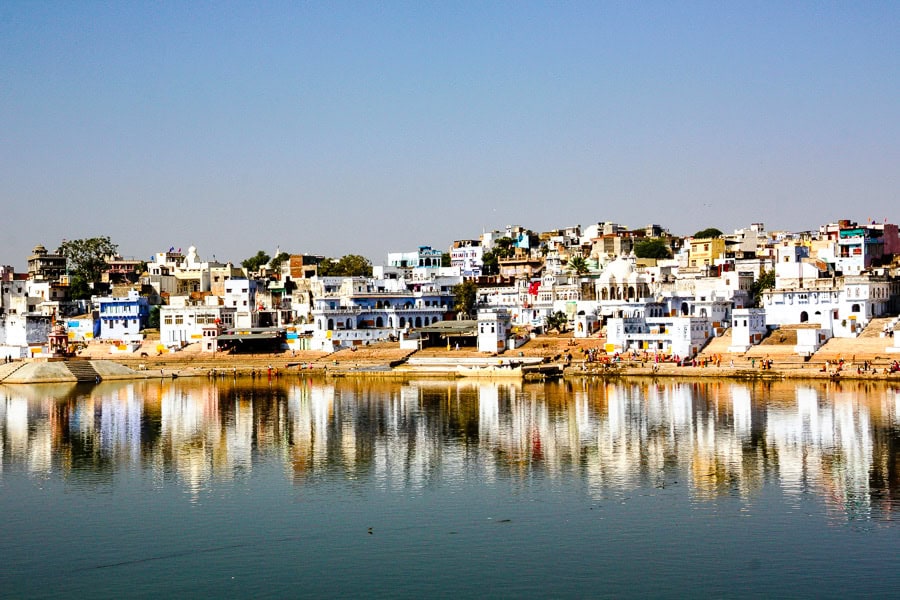
Where to stay in Pushkar
Pushkar has a reasonable range of accommodation options centred around the lake and in quieter areas on the outskirts.
Budget travellers will find plenty of simple guesthouses and hotels offering basic rooms, while a handful of mid-range hotels and heritage havelis provide comfortable stays with traditional charm. There are also a couple of higher-end resorts set in peaceful locations outside town, often with views of the surrounding hills.
The following options in Pushkar get consistently good reviews:
- Good value: Kanhaia Haveli – A traditional haveli offering clean, air-conditioned rooms just 500 metres from Brahma Temple and a short walk to Pushkar Lake. This popular option features a rooftop vegetarian restaurant, peaceful courtyard and helpful staff.
- Mid-range: Gulaab Niwaas Palace – This hotel overlooking Pushkar has spacious rooms with balconies, a swimming pool, and beautiful views of the lake and town. It’s a 10-minute walk from Pushkar Lake and has an on-site restaurant serving decent vegetarian food.
- Spend a bit more: Pratap Mahal Pushkar – A luxury resort located 10km from Pushkar Lake, offering spacious rooms with modern amenities, an outdoor pool, and onsite bar and restaurant. Guests here often single out the professional, courteous staff for particular praise.
We stayed at Green Park Resort, a decent enough, older-style budget option with basic rooms located a ten-minute walk from Pushkar Lake. The hotel is set in a nice leafy garden and has a decent sized pool.
Leg 3: Pushkar to Bikaner
Highlights: Karni Mata Rat Temple | Junagarh Fort | Bhandasar Jain Temple | Devi Kund
Total driving distance: appx. 260km (160 miles)
Total driving time: appx. 5 hours
Overnight: Bikaner (2 nights)
After spending the morning in Pushkar, set off on the long drive of some 250-odd kilometres (around 5-6 hours) to Bikaner.
Meet the holy residents of Karni Mata Rat Temple, Deshnok
As the shadows start to lengthen, you might be tempted to bypass quirky Karni Mata Temple (40 minutes south of Bikaner) in favour of that nice shower and hot meal you’ve been daydreaming about. Resist the temptation.
I’ll be honest though, Karni Mata Temple is not for the squeamish. Musophobics might like to keep driving at this point.
If you don’t mind sharing your space with twenty thousand or so rats though, Karni Mata is about as unique an experience as it gets.
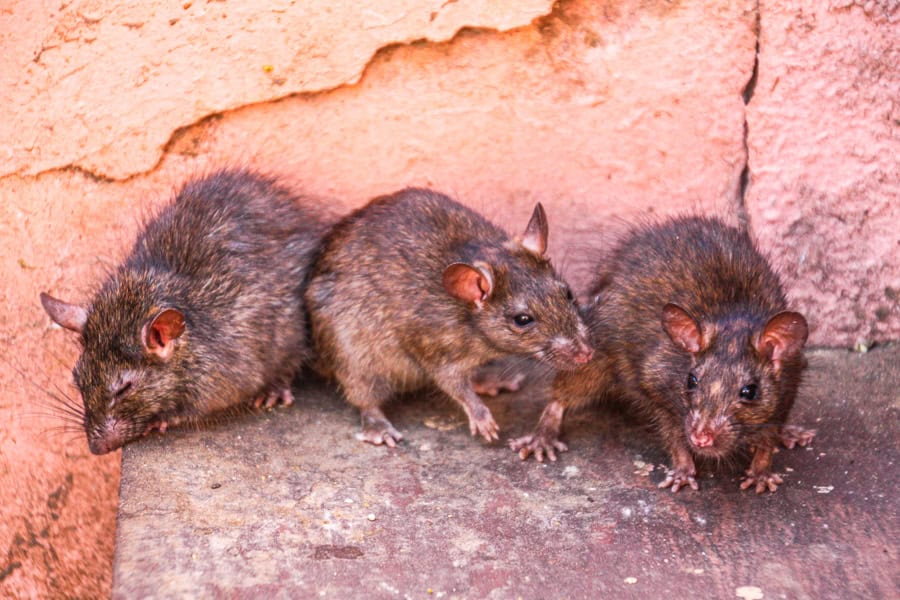
Legend has it your rattie hosts are reincarnated descendants of Karni Mata, a 15th-century miracle worker revered as the incarnation of the goddess Durga.
In addition to dodging scuttling rats while keeping your eyes peeled for one of the rare, and especially holy white rats, be sure to appreciate the delicately carved marble entranceway and solid silver doors of the temple. Before you run for the safety of your car.
Oh and try to remember, if a rat does scuttle across your bare feet, it’s considered incredibly auspicious!
Read more about our experience at Karni Mata Temple in this post.
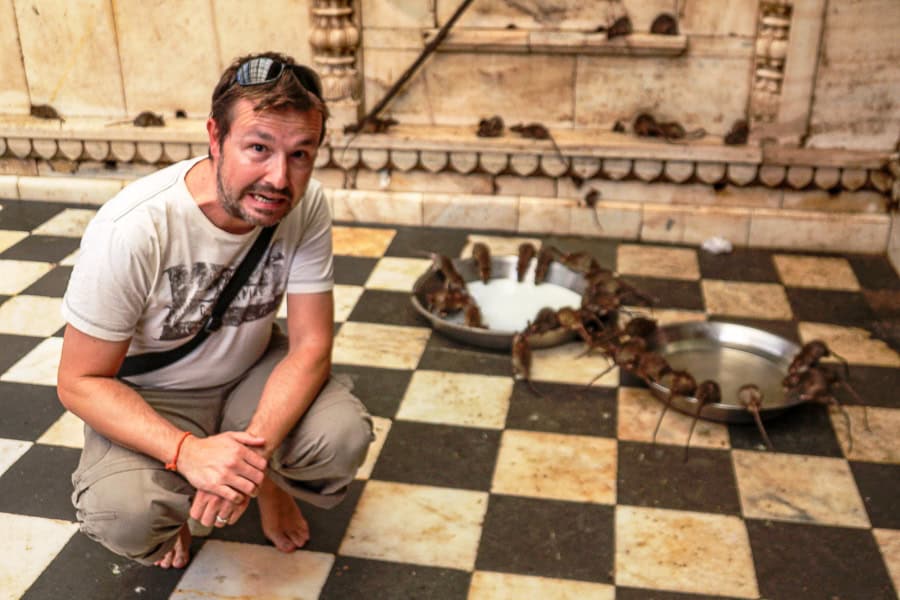
Explore the highlights of Bikaner
Sometimes overshadowed by its more famous neighbours in the Golden Triangle, the regal city of Bikaner is packed full of architectural gems that conjure up a tangible sense of the city’s royal past.
That palpable sense of history is immediately apparent when you enter monumental Junagarh Fort. Spending a few hours wandering through the many royal palaces, pavilions, temples, audience halls and courtyards here feels like a journey through Bikaner’s rich history, reflecting the variety of architectural and artistic influences that have shaped the city over hundreds of years.
While you’ll no doubt find your own favourite spots within the fort, it’s certainly worth lingering in the ornately carved and ambient Durbar Hall, and seeking out the beautifully painted walls and ceilings of Badal Mahal, the opulently adorned Anup Mahal, and the colourfully painted Gaj Mandir Palace.
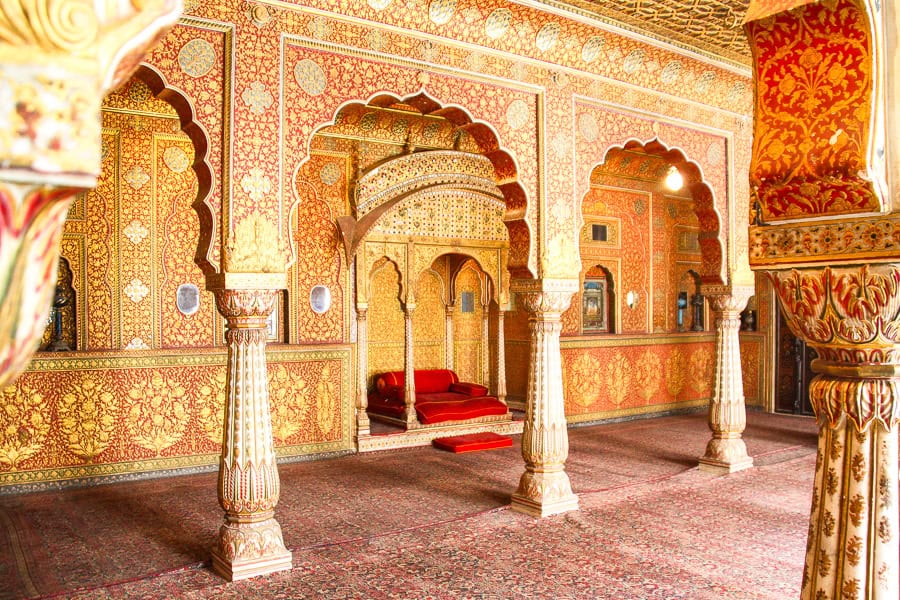
Wandering through the tangled laneways and markets of the old city, dodging rickshaws, marvelling at impressive old havelis and shrines, while avoiding the occasional meandering cow was another of our highlights of visiting Bikaner.
Try to finish your stroll at the glorious marble façade of Bhandasar Jain Temple, famed for its ornate carvings, beautiful frescoes and acclaimed mirror work. It’s definitely a place not to miss.
From something a little offbeat, discover everything you never thought you needed to know about camels at the National Research Centre of Camel, around 9km from town. These cleverly-evolved beasties are studied and bred here, and in addition to the highlight of seeing baby camels (all the incentive we needed), you can also try out camel milk kulfi and lassis (surprisingly yum!) from the camel milk parlour.
Then enjoy the late afternoon sun at ambient Devi Kund, a royal crematorium where the beautifully designed cenotaphs are each dedicated to a different ruler.
Where to stay in Bikaner
Accommodation options in Bikaner range from grand heritage hotels set in former palaces and havelis, to modern mid-range hotels and budget guesthouses and homestays. Many properties feature Rajasthani décor and rooftop terraces. Whether staying within the bustling old town or in quieter areas nearby, Bikaner offers a range of options to suit different travel styles and budgets.
The following options get consistently good reviews:
- Good value: The Prince Haveli – Family-run guesthouse offering clean, comfortable rooms with air-con and city views, set in a historic haveli. Located 2km from Bikaner Railway Station, the property features a restaurant, sun terrace, and offers both breakfast and dinner, with tuk-tuk transport arranged by the attentive hosts.
- Good value: Hotel Jaswant Bhawan – Family-owned property offering clean, spacious rooms with modern amenities, air-con, and private bathrooms. Located near Bikaner Railway Station, the hotel features a restaurant, garden and terrace, with free on-site parking and both breakfast and dinner available.
- Mid-range: Cavalry Villa – Family-friendly homestay in Bikaner with nicely furnished rooms offering garden views, air-con and private bathrooms. Located near Bikaner Railway Station, the property provides free parking, a communal dining area for breakfast and dinner, and a peaceful garden with sun terrace and picnic spots.
Leg 4: Bikaner to Jaisalmer
Highlights: Khichan Bird Sanctuary | Jaisalmer Fort | Bada Bagh | Desert Safari
Total driving distance: appx. 330km (200 miles)
Total driving time: appx. 5 hours
Overnight: Jaisalmer (3 nights)
Pause to stretch your legs with the Khichan cranes
If you’re bird nerds like us, you might like to break up the journey with a mid-point stop at the dusty town of Khichan.
Here, between late August and March each year, thousands of demoiselle cranes migrate across the subcontinent, from beyond the Himalayas, to their favourite Indian holiday spot.
There are daily feedings in the early morning but apart from that, we’re not sure what it is about this dusty, middle-of-nowhere spot that draws these elegant birds. Read about our experience of Khichan Bird Sanctuary.
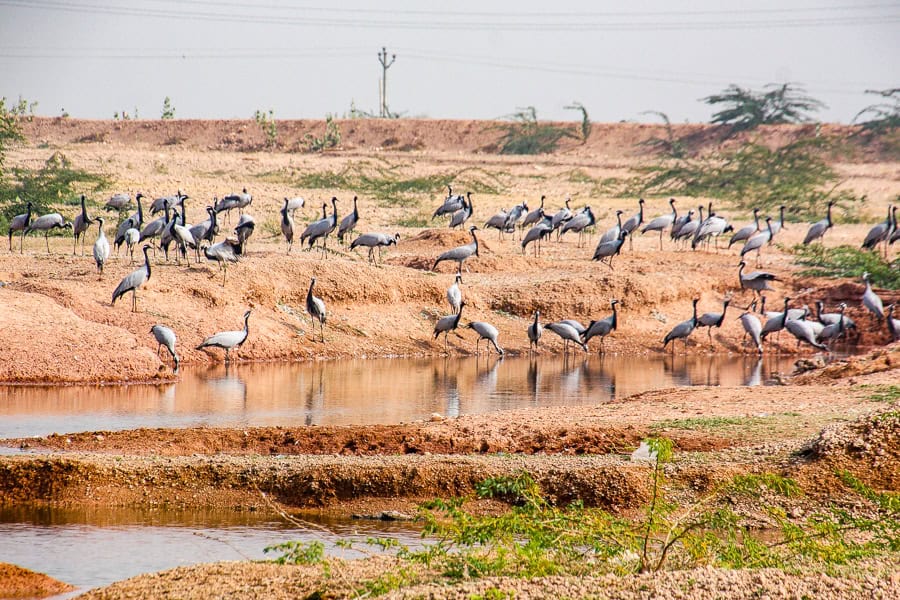
Discover the desert outpost of Jaisalmer
It’s a long, long 330-kilometres (5+ hour) drive between Bikaner and the desert outpost of Jaisalmer, perched on the edge of the Great Thar Desert. Given the distance, it’s worth spending 3 nights in Jaisalmer.
It’ll be well into the afternoon before you spy the amazing Jaisalmer Fort, perched impossibly high above the surrounding desert plains like some kind of mirage on the edge of the desert.
We felt there was something quite magical about our first afternoon exploring the fort’s sites, including the intricate carvings of the golden sandstone Jain temple complex (seven interlinked temples, including Chandraprahbu and Parasnath) as well as the Maharaja’s Palace.
Before you get too immersed in your explorations though, be sure to allow enough time for a drive out into the surrounding plains for panoramic views of the fortress in all its glory as the walls turn golden in the late afternoon sun.
Then, take a drive ten minutes northwest of the city to the royal cenotaph site of Bada Bagh. Explore the ornate royal chhatris of Jaisalmer maharajas from the 18th-century and enjoy the incredible views back towards the immense walled city as the sun drops.

Staying within Jaisalmer Fort
When we first travelled to India, we stayed in a lovely haveli built into one of the fort bastions of Jaisalmer. While it was a very cool experience, we’ve since learned that centuries of poor sewage and sanitation systems are causing the fort foundations to sink and the sandstone to degrade and crumble.
Steps are being taken to improve the systems and repair damage, but as travellers, we would certainly think twice about staying within the fort again and contributing to the damage. We recommend researching the matter further when it comes to choosing your accommodation and considering a stay in the town outside the fort walls.
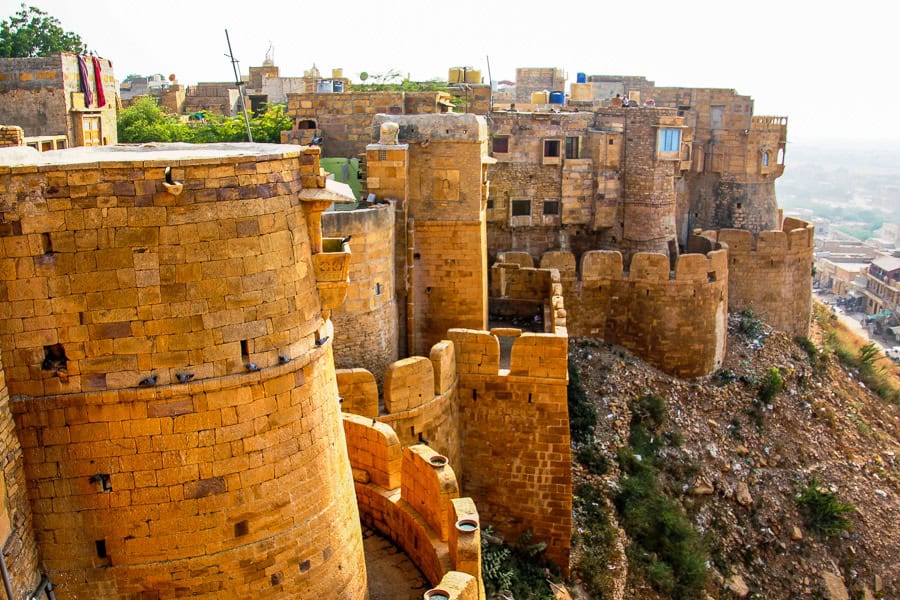
You’ll likely want to spend at least another day within the fort precinct, exploring its wonderful labyrinth of narrow stone lanes, chai shops, and elaborately designed havelis, including beautiful Patwa-ki-Haveli, Nathmal-ki-haveli and Salim Singh-ki-Haveli.
Jaisalmer also has an abundance of interesting textile shops and, although not huge shoppers, we couldn’t help stopping by a handful of enticing shops selling beautifully embroidered wall hangings and bedding.
Camel safaris in Jaisalmer
Camel tours are big business in Jaisalmer and you’ll certainly be hassled at some point about signing up for one.
We opted for a short afternoon camel ride to the Sam sand dunes for sunset. The scenery was lovely as the sun dropped, but if we had our time again, we’d probably explore one of the other options available for experiencing the western desert, like a camping experience or a 4WD dune adventure.
Truth is, the slow lurching, lunging ‘camel massage’ isn’t an experience we particularly enjoy. Nor do the camels, judging by their grumbles and protests.
We leave it up to you, but recommend researching companies and their approach to the care and welfare of their animals before signing up for a tour.
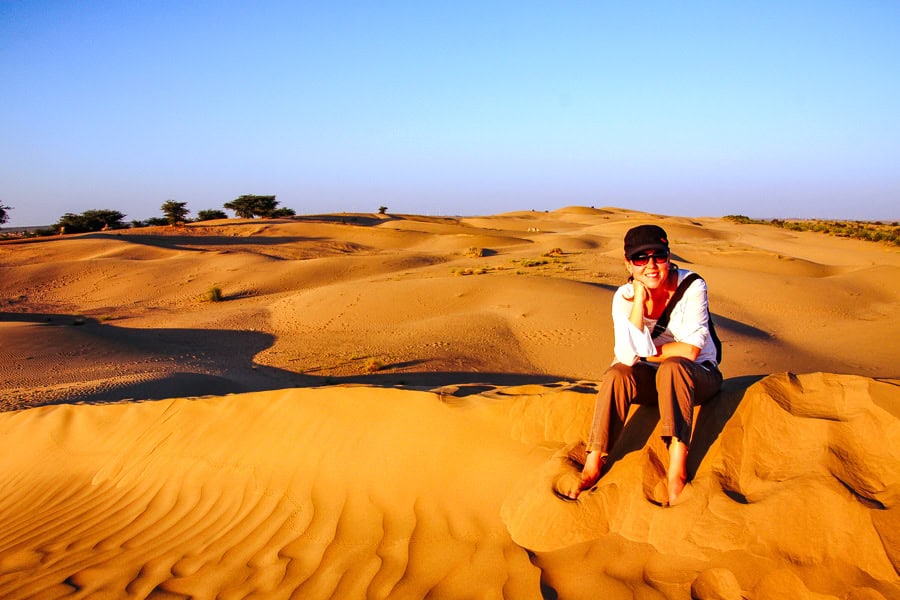
Where to stay in Jaisalmer
There’s a huge amount of choice when it comes to stays in Jaisalmer, covering everything from budget guesthouses to luxury desert camps. The main areas to stay include the fort itself, the streets around Gandhi Chowk, and the Sam Sand Dunes area, 40km outside the city.
As we mentioned, while staying inside the fort may seem appealing, many travellers now avoid it due to concerns about the impact on its fragile structure.
Instead, there are plenty of guesthouses and hotels with fort views just outside the walls, offering easy access without contributing to the damage. The following options get consistently good reviews:
- Good value: Shahi Palace Hotel Jaisalmer – Located just 200 metres from Jaisalmer Fort, this lovely haveli hotel has clean, air-conditioned rooms with private bathrooms and a rooftop restaurant and terrace with panoramic fort views.
- Mid-range: Hotel Pleasant Haveli – Traditional haveli-style hotel 500 metres from Jaisalmer Fort, with spacious air-conditioned rooms, excellent customer service and very popular rooftop restaurant with fabulous views of the fort.
- Spend a bit more: 1st Gate Home – Fusion – Stylish hotel located just 200 metres from Jaisalmer Fort, offering spacious air-conditioned rooms with traditional decor, a rooftop vegetarian restaurant with fort views, and a small pool.
- Indulge: Suryagarh Jaisalmer – Luxurious hotel in a peaceful desert setting 16km from Jaisalmer Fort. Rooms are spacious with traditional furnishings, modern amenities and heritage touches. Facilities include indoor pool, spa, fitness centre, landscaped gardens, fine dining and rooftop lounge.
Leg 5: Jaisalmer to Jodhpur
Highlights: Mehrangarh Fort | Jodhpur Old City | Umaid Bhawan Palace | Jaswant Thadam
Total driving distance: appx. 270km (170 miles)
Total driving time: appx. 4.5 hours
Overnight: Jodhpur (2 nights)
We’re into week two of our itinerary for India’s northwest, and this stretch serves up another epic 270-kilometres (4-5 hour) drive from Jaisalmer to the Blue City of Jodhpur.
Thanks to an early start you’ll arrive late morning, so after dropping off your bags you have all afternoon to explore perhaps the most imposing fortress in all of Rajasthan, the mighty Meherangarh Fort.
It’s impossible not to be awed by Meherangarh, dominating the skyline from its perch 125-metres above the bustling city of Jodhpur.
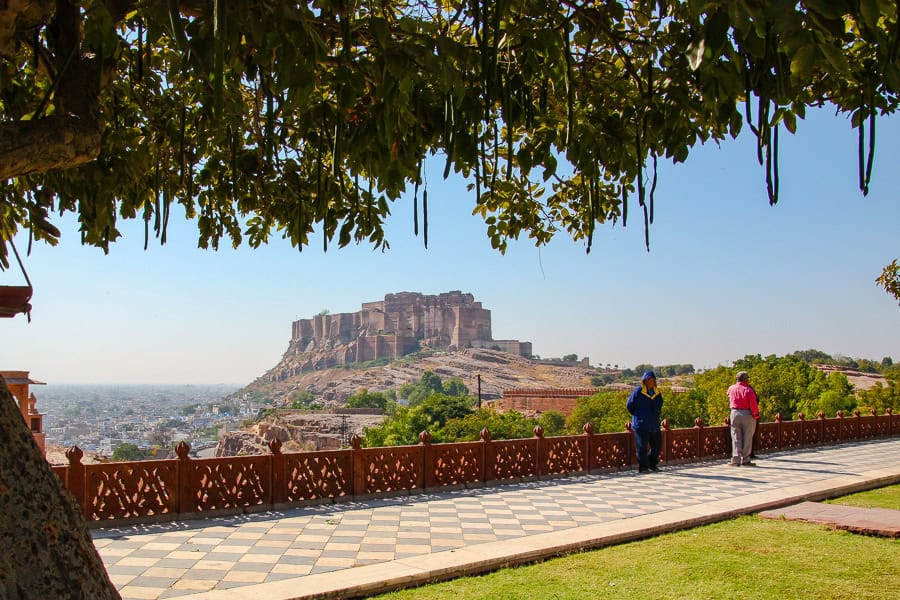
That sense of awe increases as you navigate the incline through a series of immense gates, each with their own story to tell. The 19th-century cannonball marks at Dodh Kangra Pol speak of a turbulent past; the intimidating spikes at Loha Pol conjure the dread that invading armies might have felt; while the handprints inside the same gate tell their own sad story of queens that have committed sati (self-immolation).
Make the best of the awesome audio tour to get the most out of the usual mix of impressive palaces, ornate halls, revered temples, relaxing gardens, and perhaps Rajasthan’s most eclectic and impressive museum.
The highlight for us was a stroll around the magnificent ramparts, where the panoramic views over the blue-painted houses of the old city below bring home the reason for Jodphur’s nickname: the ‘Blue City’ of Rajasthan.
We’d highly recommend ending your day on one of the city’s rooftop eateries, where you can digest the day’s adventure over a beer, with the ambiently lit fort as a backdrop.
Day 2 in Jodhpur
There’s plenty to see and do on a second day in Jodhpur, even though Meherangarh will never be far from your mind, or indeed your view.
Take a wander through the narrow alleyways of the Old City, overlooked by the Ghanta Ghar clocktower, before tempting yourself with textiles, spices, handicrafts and sweet offerings of Sardar Market.
It’s also worth checking out Umaid Bhawan Palace for a taste of the life of the maharajas: it’s still the vast home of Jodhpur’s former royals (India’s many royal families had their official royal status removed following Indian independence from Britain). Part of it is also an upmarket hotel, but you may well need the resources of a maharaja to stay there.
If you can’t resist one final, spectacular view of Meherangarh Fort (in our opinion, the most epic view), head to Jaswant Thadam, a beautifully carved white marble memorial to Maharaja Jaswant Singh II. The gardens here are lovely. The huge flocks of pigeons, not so much.
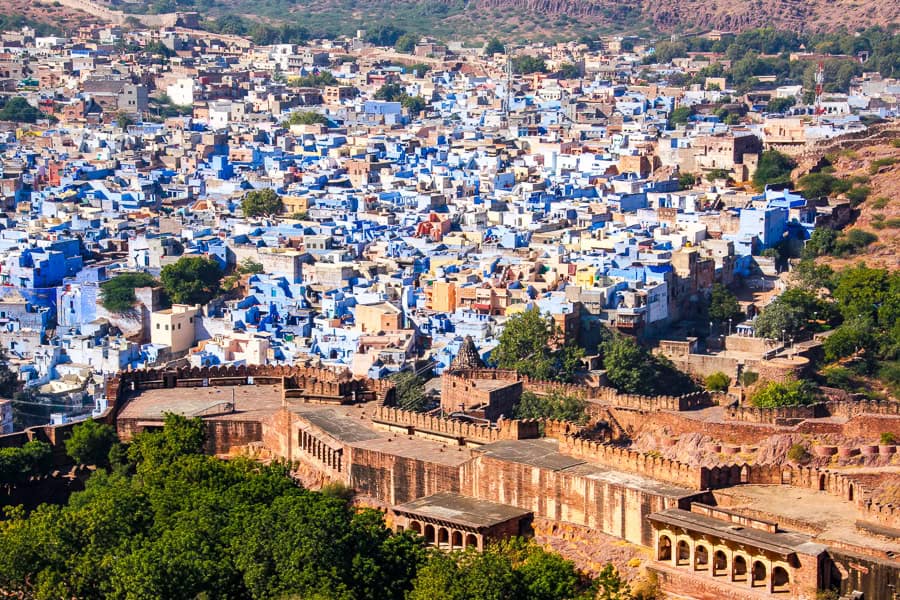
Where to stay in Jodhpur
Accommodation options in Jodhpur range from heritage hotels in restored palaces to budget-friendly guesthouses and modern resorts. Many properties offer views of Mehrangarh Fort or the old city skyline.
Luxury stays often include courtyards, pools, and traditional Rajasthani décor, while smaller boutique hotels provide a more personal experience. Whether in the heart of the old city or on its quieter outskirts, there’s something to suit different budgets and preferences.
The following options get consistently good reviews:
- Good Value: Dev Kothi – Boutique Heritage Stay – Centrally located in Jodhpur’s old city, this family-run guesthouse offers spacious, air-conditioned rooms with traditional décor and private balconies. The property has a rooftop terrace with views of Mehrangarh Fort and breakfast is included.
- Mid-range: Khamma Heritage – Heritage-style guesthouse in the heart of Jodhpur, featuring spacious, air-conditioned rooms with private bathrooms and a rooftop terrace overlooking Mehrangarh Fort.
- Spend a bit more: Daspan House – Boutique hotel set in restored mansion, offering spacious, light-filled rooms with elegant interiors, powerful showers, and garden views. Facilities include a rooftop pool, bar, and restaurant, with breakfast and parking included. Located 10 minutes by tuk-tuk from the old town.
- Spend a bit more: Taj Hari Mahal Jodhpur – Luxury hotel set in 6 acres of landscaped gardens, featuring spacious, stylish rooms with modern amenities, a large outdoor pool, spa, and multiple dining options. Located 3.5km from Jodhpur Railway Station.
Leg 6: Jodphur to Kumbhalgarh via Ranakpur
Highlights: Chaturmukha Dharana Vihara Jain Temple | Kumbhalgarh Fort | Sunset at Ranakpur Dam
Total driving distance: appx. 200km (125 miles)
Total driving time: appx. 4 hours
Overnight: Kumbhalgarh
Marvel at the white marble elegance of Ranakpur’s Jain Temple
The main four-sided white marble masterpiece of the 15th-century Jain temple, Chaturmukha Dharana Vihara, literally took our breath away.
1,440 artfully carved columns support an elegant, interconnected series of engraved halls and domes that enfold a central sanctuary and shrine.
It’s really worth spending some time here to fully appreciate the artistry of the carved reliefs throughout the temple. If you have time, check out the two smaller temples nearby.
You may get lucky like us and have the place largely to yourself, with just a few busy green parrots for company.
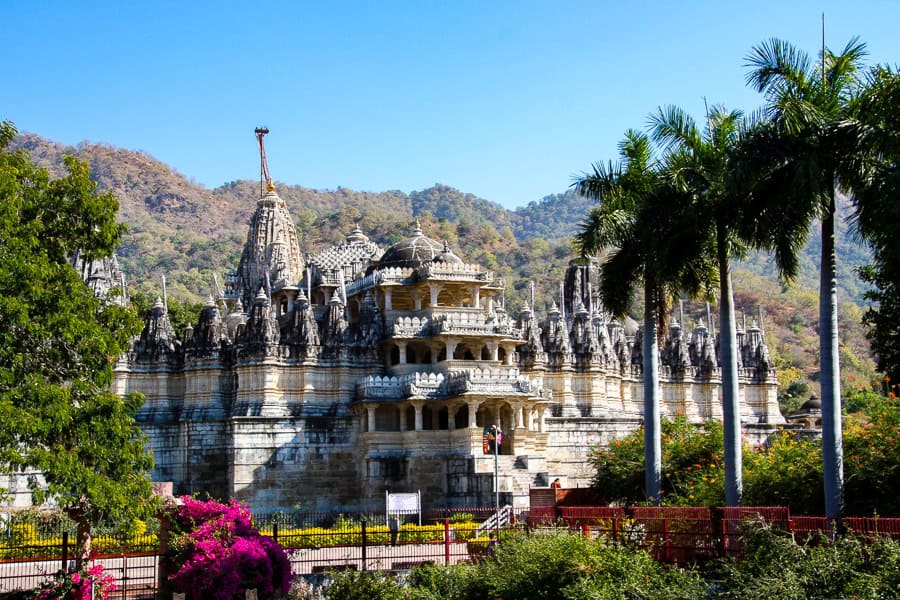
It will most likely be late afternoon by the time you finish at the temple, and we’d highly recommend a short detour before recharging your batteries for the night in Kumbhalgarh.
There’s something special about ending a long busy day with a serene scene and a spectacular sunset, and Ranakpur Dam serves up both. It’s just near the temple.
Find a comfortable spot and enjoy the views across the tranquil waters of the dam, the sound of birdlife, and nature’s greatest show as the sun drops behind the Aravalli mountain range.
Kumbulgarh town is about an hour or so from the temple precinct, so make your way there for the night. Tomorrow morning, you’ll hit up Kumbhalgarh Fort.
Witness the winding walls of Kumbhalgarh Fortress
It’s only a short drive from Kumbulgarh to Udaipur today, so you’ll have plenty of time to wander the mountain fortress of Kumbhalgarh.
You’d be forgiven for thinking you’ve teleported to China as you gaze over the truly immense 36-kilometre defensive walls of this epic fort. They rise and fall over the hills as far as the eye can see.
This World Heritage-listed monolith has been standing guard from its 1,100-metre high perch in the Aravalli range for almost 600 years. You’ll need a couple of hours at least to climb the steep slope up to the fort and explore the palaces and Jain temples within. The real highlight here though is the view from the ramparts.
If you have more time and plenty of energy, it’s possible to walk a circuit of the walls in two days (!), and there are various walks and nature trails in the area, including Kumbhalgarh Wildlife Sanctuary.
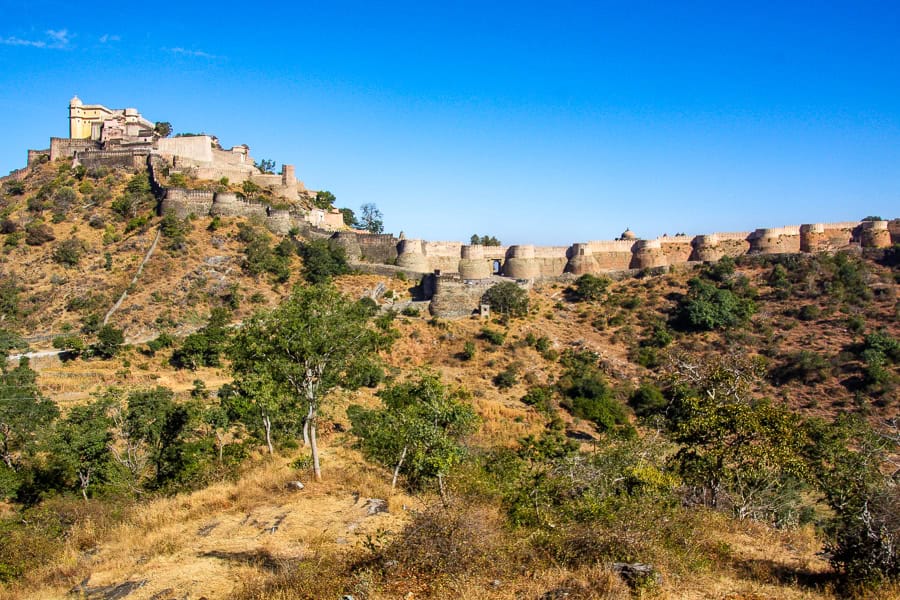
Where to stay in Kumbulgarh
Despite being a small town, Kumbhalgarh has a decent enough range of accommodation, mostly clustered around the fort itself, offering easy access to the main sights of the area. The village of Kelwara, just a few kilometres away, also has a few places to stay.
Options in the area cover the usual range of styles and price points you’d expect in India, from budget to luxury stays. The following options get consistently good reviews:
- Good value: The Sky Imperial Pavoreal Jungle Resort – Peaceful hotel located 10km from the fort with clean, spacious rooms with views. Hotel facilities include sun terrace, swimming pool and gardens with a family-friendly restaurant.
- Mid-range: Raajsa Kumbhalgarh – Located around 8km from the fort, this resort offers comfortable, modern, well-appointed rooms with air-con. Facilities include gardens, pool and spa, fitness centre and on-site restaurant.
- Spend a bit more: Radisson Blu Resort Kumbhalgarh – 5-star hotel offering spacious, modern rooms and suites along with resort facilities, including spa, swimming pool, fitness centre, and lovely terrace. Located around 7km from the fort.
Leg 7: Kumbhalgarh to Udaipur
Highlights: Lake Pichola | Udaipur City Palace and Museum | Jagdish Temple | Jag Mandir Island | Monsoon Palace | Bangore-ki-Haveli
Total driving distance: appx. 85km (50 miles)
Total driving time: appx. 2 hours
Overnight: Udaipur (3+ days)
Dedicate three or more days to the beautiful city of Udaipur – there’s lots to do here.
From Kumbhalgarh, it’s 85-kilometres and two hours’ driving to the city of Udaipur (so it’s also possible to visit Kumbhalgarh as a day trip from Udaipur).
After two busy weeks on the road there was something extra special about slowing the pace of our Rajasthan road trip in Udaipur. We kicked back on our first evening with a Kingfisher beer and a sunset of molten gold on a quiet rooftop overlooking Udaipur’s beautiful Lake Pichola. It was a ritual we went on to repeat every evening we were here.
Udaipur’s highlights are many, not least of which is that it’s a city on a lake surrounded by mountains – a welcome change after many long and dusty days in and around the Thar Desert. We spent three nights in this lovely city and would recommend giving it at least that to appreciate the sites in the city and the surrounding area.
Perhaps the biggest drawcard is Udaipur City Palace and Museum, the largest palace in Rajasthan. It’s an extraordinary labyrinth of history, architecture and intricate décor, including the unmissable Durbar Hall. City Palace is in an impossibly picturesque spot right on the edge of the lake, looking every bit like a giant cruise ship at port. Get here very early or wait until late in the day, as it gets seriously busy.
While you’re visiting City Palace, be sure to also seek out nearby Jagdish Temple, a 17th-century masterpiece renowned for its architecture and incredibly detailed carvings.
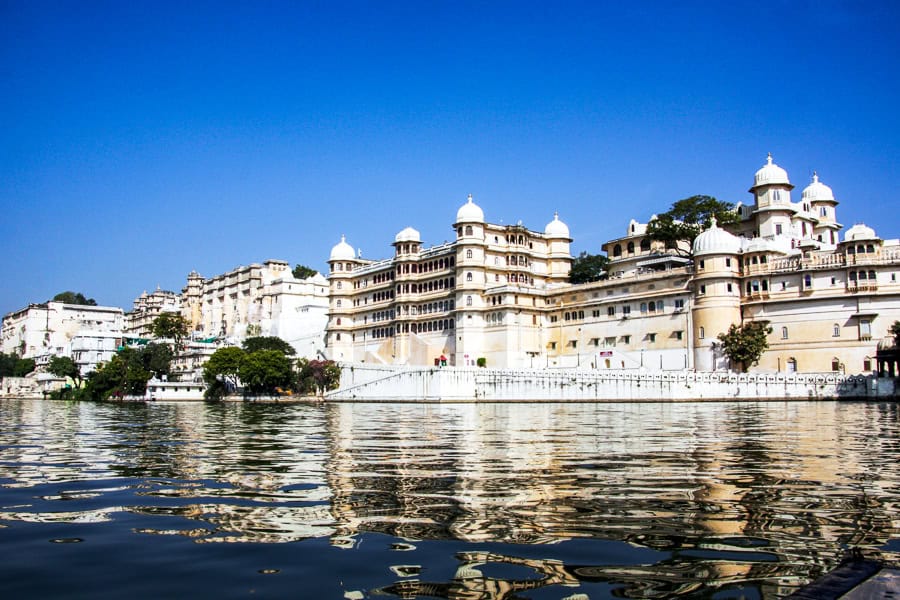
No visit to Udaipur would be complete without a boat ride on Lake Pichola. There are a couple of islands to visit. We opted for a trip to Jag Mandir Island and Lake Garden Palace. Built over the 16th and 17th centuries, it was a royal summer escape. Today, it houses a small hotel set amidst pretty gardens and offers lovely views across the lake towards the city and mountains.
Speaking of views, after a while most visitors to Udaipur find themselves gazing off into the distance wondering what it is that sits atop that mountain on the horizon. Give in to your curiosity if you have the time, and visit the lofty heights of the Monsoon Palace. This former royal retreat is definitely past its heyday, but the sweeping views over Udapiur are magic.
There’s so much more to see in and around Udaipur, but in the interests of brevity, our recommendations include the 18th-century Bangore-ki-Haveli and, if you’re after more views, Sunset Point Park. It’s a brisk hill hike or you can take the cable car to Machla Magra hill. A short drive out of town is the ambient royal cremation ground at Ahar.
It’s pretty clear though, our next visit will to Udaipur will need to be for a month.
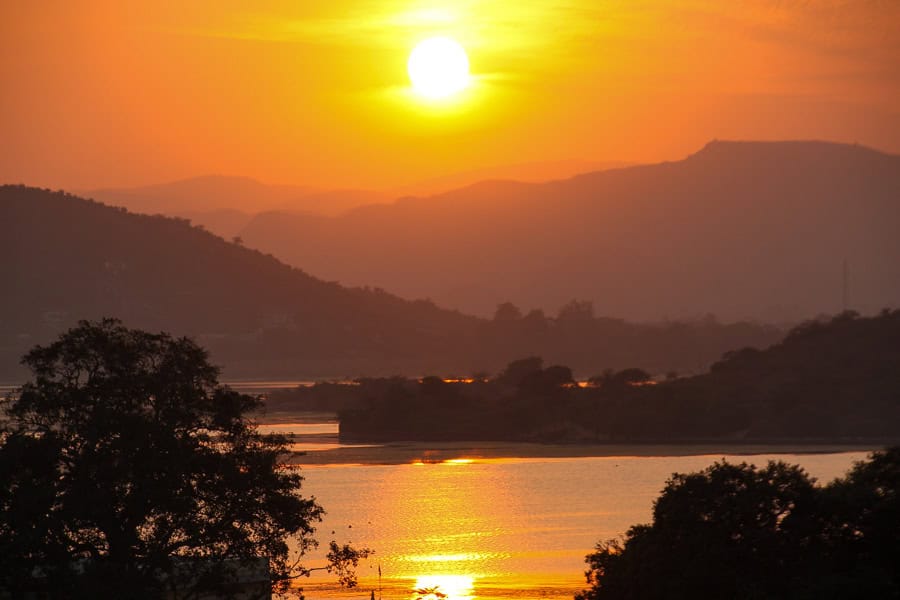
Where to stay in Udaipur
As a popular tourist town, you’ll find a wide range of accommodation in Udaipur, from budget guesthouses to luxury heritage hotels. The old city, around Lake Pichola, is the most popular area, with narrow lanes, rooftop restaurants, and guesthouses with lake views.
For a quieter stay, areas like Fateh Sagar Lake and the outskirts offer larger resorts and boutique hotels with gardens and pools. The following options get consistently good reviews:
- Good value: Madri Haveli – Lovely restored haveli with the perfect blend of modern comfort and traditional charm in the old city. Rooms are clean and comfortable and there’s a great rooftop restaurant with city and lake views.
- Mid-range: Oolala Udaipur – Lakeside homestay in a quiet spot with exceptionally friendly, helpful hosts, colourful, comfy lake view rooms, and a tasty Indian or continental brekky included in the price.
- Spend a bit more: Trident Udaipur – Luxurious hotel located on Lake Pichola with modern rooms that incorporate traditional design touches, comfortable beds, quiet AC, and the usual range of resort facilities including a large outdoor pool.
We stayed at Jaiwana Haveli located right on the lake in Udaipur’s old town and just a few minutes’ walk from City Palace and Jagdish Temple. We had a simple, clean room with ensuite bathroom and lake views. Staff were super friendly and we loved the rooftop restaurant; it was the perfect spot for a daily sundowner.
Leg 8: Udaipur to Bundi via Chittorgarh
Highlights: Chittor Fort | Taragarh Fort | Bundi Palace
Total driving distance: appx. 270km (170 miles)
Total driving time: appx. 5+ hours
Overnight: Bundi
It takes more than 5 hours to drive between Udaipur and Bundi, covering around 270-kilometres so we suggest breaking up your journey around halfway, in the town of Chittorgarh. It’s here that you’ll find the largest fort in India, the World Heritage-listed Chittor Fort.
Be awed at Chittor Fort, India’s largest fortress
The site of three major sieges by Muslim invaders, Chittor Fort is set high on a hill and sprawls over some 700 acres. You’ll need wheels, and around three or more hours, to get around and see all the key sites.
Highlights of the fort include Rana Kumbha palace, a vast 15th-century structure; the 16th-century Rana Ratan Singh palace; and the museum in Fateh Prakash palace.
Don’t miss the fort’s two iconic towers: the leaning, 15th-century Vijay Stambha (Tower of Victory), and the much older Kirti Stambha (Tower of Fame).
If you’re travelling from Udaipur, you’ll likely arrive in Bundi late in the afternoon. We recommend spending the night in Bundi and saving your energy for exploring its highlights in the morning.
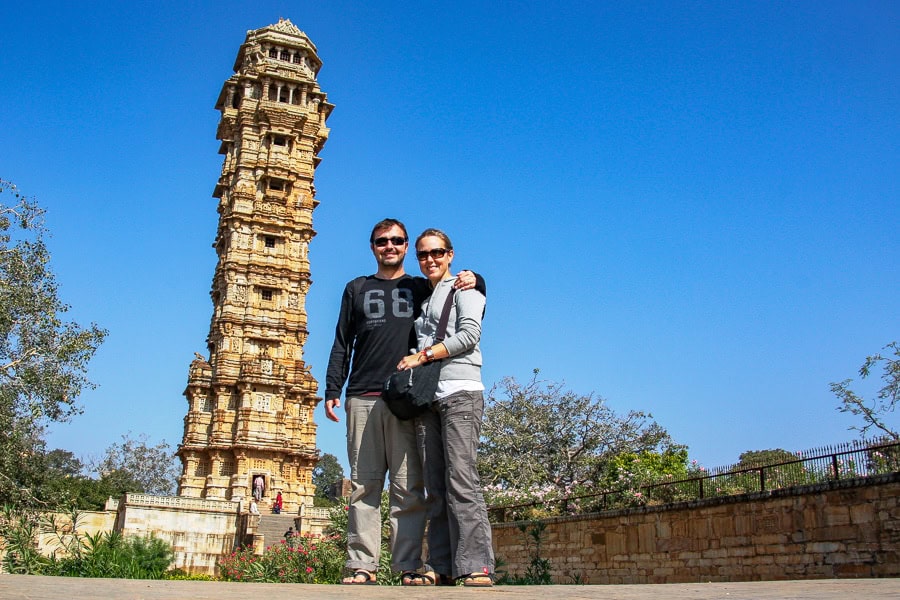
Discover the forgotten glory of Bundi
Waking to the huge rise of 16th-century Taragarh Fort shrouded in the morning mist was probably the highlight of Bundi for us.
Before you hit the road again, organise a guide and spend the morning exploring the fort and Bundi Palace. It has some beautiful, still-colourful murals of scenes from the life of Krishna. These are hidden away behind locked doors, which can only be accessed by the palace’s keepers (more reason to have a guide).
It’s also worth taking some time to wander through the old town and search out Bundi’s famous stepwells. They’re extraordinary though, like the palace, some are fairly dishevelled these days.
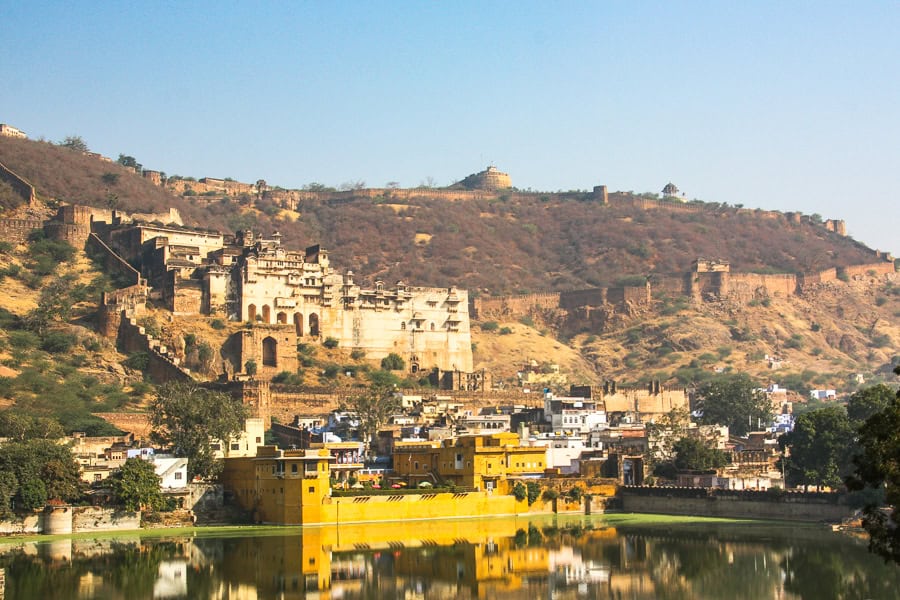
For us, Bundi was a strange place. We seemed to be the only tourists there when we visited and, apart from our guide, we were accompanied only by the monkeys that inhabit the fort and palace, and the green parrots on the ramparts.
Rudyard Kipling’s famous quote about the palace is one that perhaps best captures our own sentiments: ‘the Palace of Bundi, even in broad daylight, is such a palace as men build for themselves in uneasy dreams — the work of goblins rather than of men.’
Where to stay in Bundi
Bundi offers a fairly limited range of accommodation compared to more popular tourist destinations, with available stays mostly centred around the old town near the palace and lake. Most options are small, family-run guesthouses or heritage havelis, with a focus on budget and mid-range travellers.
The following options get consistently good reviews:
- Good value: Bundi Inn – Heritage haveli a few minutes’ walk from the fort, with clean, comfortable rooms and wonderful rooftop views.
- Mid-range: The Castle View Homestay – Colourful, welcoming homestay with comfortable rooms and memory foam mattresses with decent bathrooms and good showers. Rooftop terrace and restaurant with fabulous views of the fort.
- Mid-range: Dev Niwas Heritage Hotel – Lovely bright heritage hotel with clean, well-maintained facilities and small pool just a few hundred metres from the fort. Ensuite rooms are comfortable and tastefully decorated and the rooftop restaurant has excellent fort views.
Leg 9: Bundi to Ranthambore
Highlights: Ranthambore National Park
Total driving distance: appx. 140km (90 miles)
Total driving time: appx. 3 hours
Overnight: Ranthambore (2 days)
If you want to max your chances of seeing a wild tiger in Ranthambore, aim to spend a couple of days here so you can go on a few safaris. It’s a three hour, 140-kilometre drive from Bundi to Ranthambore.
Escape to the wilds of Ranthambore National Park
We arrived in Ranthambore in the late afternoon, and as we’d organised our tiger safaris in advance for the next day, we got to enjoy a rare lazy afternoon.
Ranthambore National Park is one of the biggest and most renowned national parks in Northern India. The park is located in the Sawai Madhopur district of southeastern Rajasthan, about 130-kilometres from Jaipur.
This was once a former hunting ground of Jaipur’s maharajas. Today, Ranthambore National Park is a major wildlife tourist attraction.
We suggest setting aside two days here so that you can up your chances of seeing a wild tiger by joining morning and afternoon safaris. We lucked out with a glimpse of just one tiger, and tantalising hints of others. We felt privileged to have even that experience, but actually, we were delighted to find a national park brimming with a huge range of other wildlife, from deer and monkeys to mongoose.
Check out this post where we describe our Ranthambore tiger safaris in more detail
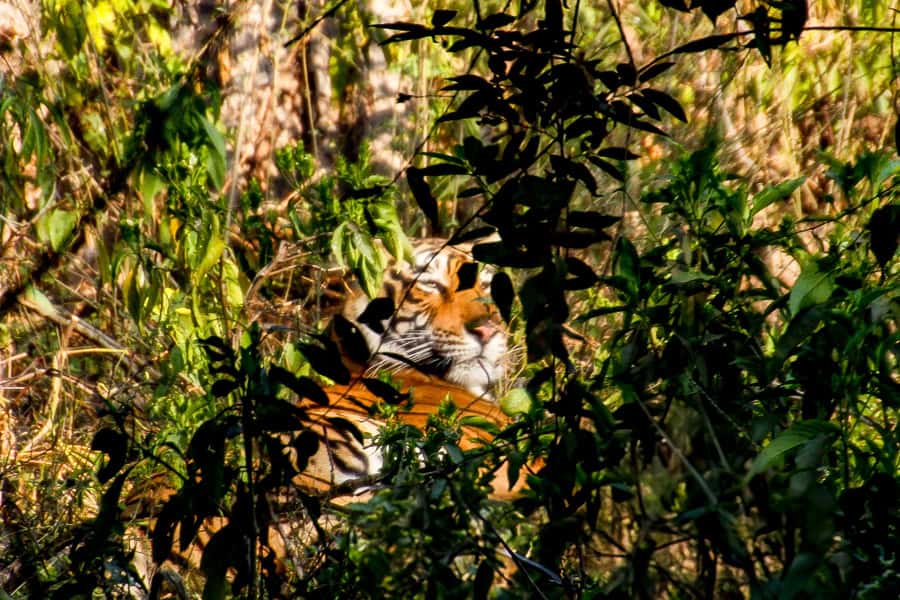
Where to stay around Rathambore National Park
There’s a decent range of accommodation around Ranthambore National Park, mostly centred in and around the town of Sawai Madhopur, which is the main access point for park safaris. Options range from simple guesthouses and budget hotels to mid-range resorts and luxury tented camps. Many properties offer packages that include game drives, meals and transport.
The following options get consistently good reviews:
- Good value: Hotel Tiger Haveli – Clean, spacious rooms with air con and private balconies, just a short walk from Sawai Madhopur’s main street and safari pick-up points.
- Mid-range: RajBagh by Aaryam – Spacious, air-conditioned rooms with balconies set in peaceful grounds with a pool, terrace and rooftop restaurant, just a short drive from Ranthambhore safari zone.
- Spend a bit more: Fateh’s Retreat, Homestay – Fancy homestay with a swimming pool and rooftop dining in peaceful, landscaped grounds overlooking Ranthambore National Park. Rooms are spacious and air-conditioned with garden or pool views.
- Indulge: Taj Sawai Ranthambore – 5-star hotel with comfortable, spacious rooms, some with private pools, in landscaped grounds close to Ranthambore National Park. There’s a large outdoor pool, spa, fitness centre, and on-site dining.
Leg 10: Ranthambore to Bharatpur
Highlights: Keoladeo Ghana National Park
Total driving distance: appx. 250km (160 miles)
Total driving time: appx. 4-5 hours
Overnight: Bharatpur
It’s a long drive from Ranthambore to Bharatpur: around 250-kilometres and up to 5 hours.
You could opt at this point to continue straight on to Agra, another hour up the road. We chose to base ourselves at Bharatpur though, as our next highlight, Keoladeo Ghana National Park, is best visited very early in the morning.
The famous ancient site of Fatehpur Sikri is also just half-an-hour from Bharatpur. While we chose to visit this ambient place in the early morning on our last leg (read about it further on), you could visit it this afternoon instead.
Greet dawn with the birds at Keoladeo Ghana National Park
Dawn found us greeting a misty scene in Keoladeo Ghana National Park, one of the world’s most important bird breeding and feeding grounds.
Like Ranthambore, this was once a royal hunting and game reserve for maharajas and the British Raj. Fortunately, in 1982 Keoladeo was declared a national park, and later listed as a World Heritage site.
Keoladeo is home to over 370 species of birds and animals, and while you can explore by foot or bike, we opted to go with one of the park’s eagle-eyed rickshaw guides.
Even if you aren’t bird nerds, cruising through the park in the early morn, spotting the park’s busy residents, whether winged, hoofed or scaled, is a wildlife highlight of a North India road trip. It ranks as one of our surprise favourite experiences on this journey.
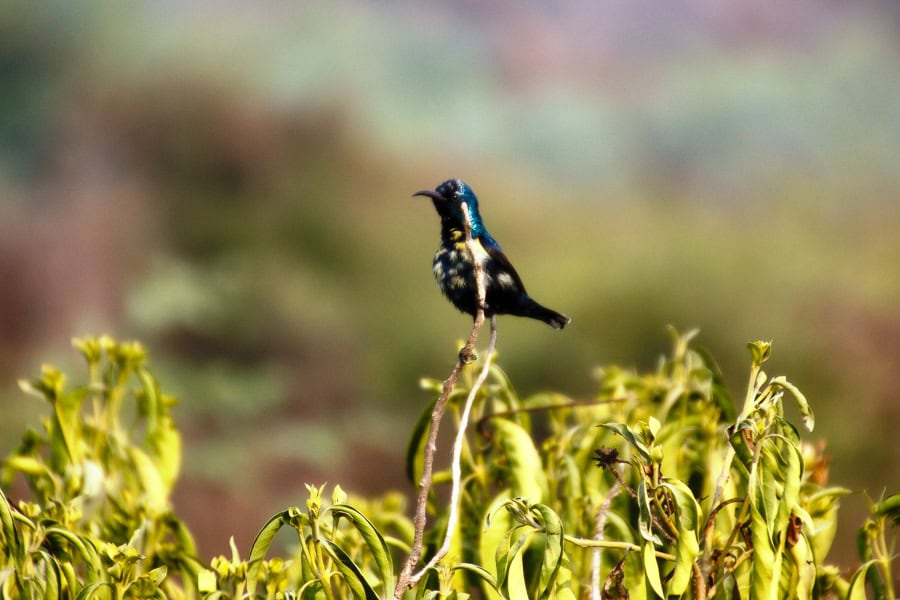
Where to stay in Bharatpur
Bharatpur has a limited range of accommodation options, mostly centred around Bharatpur city and close to Keoladeo Ghana National Park. The area around the park entrance is a popular spot to stay with a number of hotels offering easy access to early morning birdwatching tours. You’ll find most places cater to wildlife enthusiasts, with guided tours and bicycle rentals commonly available.
The following options get consistently good reviews:
- Good value: Iora Guest House – Very much catering for birders, this is one of the most popular places to stay near the park, offering simple, clean rooms with private bathrooms and air-con, just a short walk from the national park.
- Mid-range: IbisHouse Farm Stay – Located near the national park, this homestay offers modern, comfortable rooms with air-con, private bathrooms and balconies. The property provides a peaceful, birdwatcher-friendly environment with home-cooked meals.
- Mid-range: The Birder’s Inn – As the name suggests, this is another twitcher-friendly place, with spacious rooms with air-con, private bathrooms and balconies, along with a restaurant, swimming pool and garden. Located around 300 metres from the national park.
Leg 11: Bharatpur to Agra
Highlights: Taj Mahal | Mehtab Bagh Gardens
Total driving distance: appx. 55km (35 miles)
Total driving time: appx. 1 hour
Overnight: Agra (2 nights)
We’re squarely back in the state of Uttar Pradesh now and Agra is the last stop on our epic itinerary for India’s northwest. Spend a night or two here so you can make the most of the Taj Mahal and other sites.
It’s only 55-kilometres from Bharatpur to Agra, so head in that direction once your birdwatching tour is done.
Finish up with the epic wonders of Agra
A northwest India road trip wouldn’t be complete without a visit to one of the world’s most renowned monuments, the Taj Mahal.
This 17th-century monument to Shah Jahan’s most beloved wife, Mumtaz Mahal, is the highlight of Agra, and it needs no introduction.
It is worth noting that in spite of its popularity, a brief, crowd-free moment at this incredible monument is possible. Just make sure you are in the queue well before dawn, having purchased tickets at one of the nearby kiosks.
As soon as the gate opens, head into the complex, bypass the front-on view of the Taj – where most people will linger – and head straight for the eastern or western gates (to the right or left sides of the Taj itself). As one of the first there, those few moments of solitude, not to mention the crowd-free snaps, is priceless.
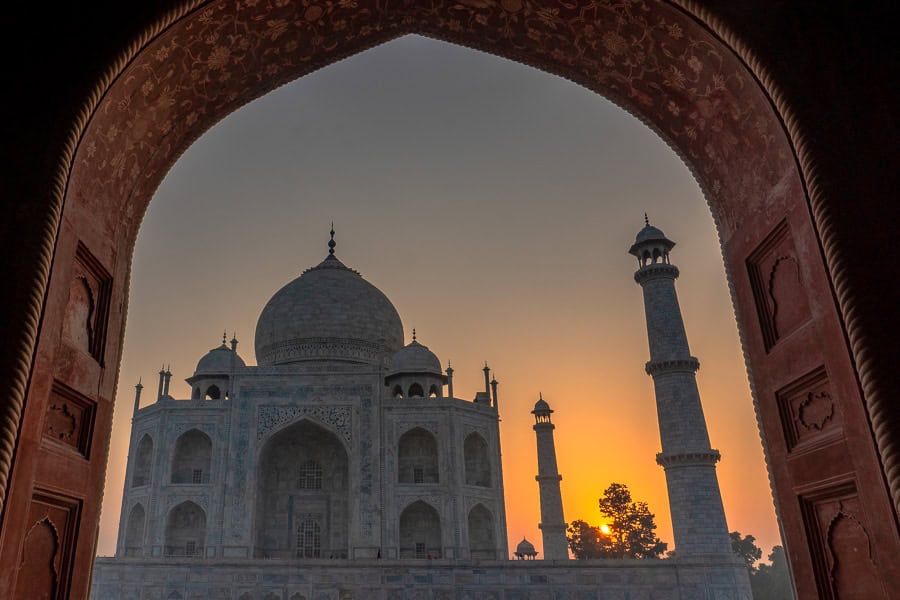
As the Taj is perfectly symmetrical, the view of the monument is similar from each gate, except from the eastern side, you’ll have the rising sun shining onto the white marble, while on the western side, the Taj will be in silhouette as the sun rises behind it. We’ve been on both sides at dawn and both are beautiful.
While you’re in Agra it’s worth taking a couple of hours to explore the dark red sandstone and marble pavilions of Agra Fort, along with the understated beauty of the baby Taj.
You can also enjoy sunset views of the Taj from the Mehtab Bagh gardens on the opposite side of the river. Or if you want a less crowded, better lubricated experience, order a beer and take in the view of the Taj from a rooftop bar nearby (low-key Hotel Kamal gets our vote).
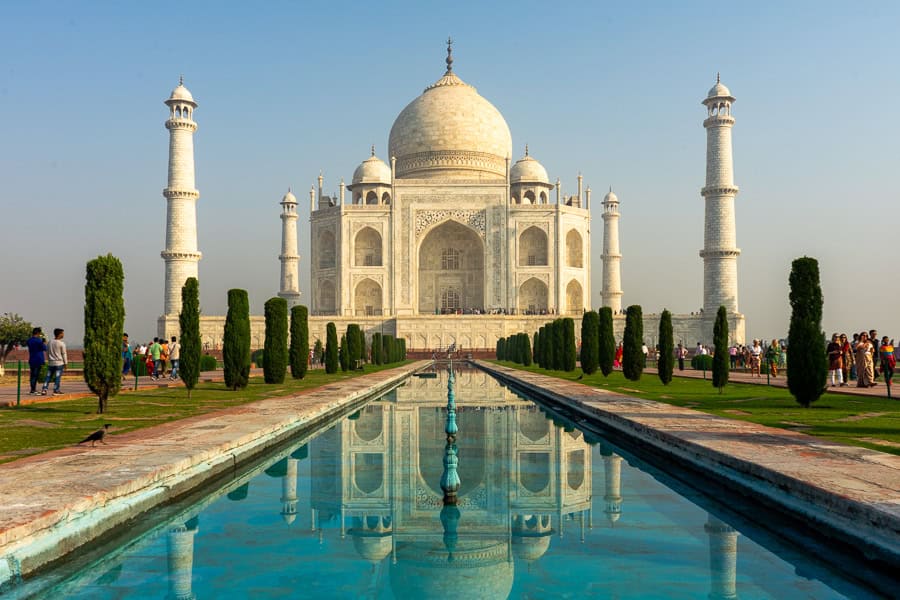
Where to stay in Agra
As the host city for India’s premier tourist attraction, it’s no surprise that there’s a dizzying choice of accommodation in Agra to suit all budgets and tastes. Fatehabad Road, Agra Fort and Sadar Bazaar are all popular areas to stay, while the Taj Ganj district is probably the most popular due to its proximity to the Taj Mahal.
While you won’t have any trouble finding a room here, you may well struggle to narrow down your options. The following stays get consistently good reviews:
- Good value: Joey’s Hostel Agra – It’s hard to go past a place that’s had more than six thousand reviews and still manages to maintain a decent rating. The hotel has basic, clean rooms close to the Taj, with great views from the rooftop café.
- Mid-range: The Coral Court Homestay – Just a 10-15 minute walk from the Taj Mahal, this homestay offers cosy, clean rooms with a terrace and city views, and a warm, welcoming atmosphere.
- Spend a bit more: Taj Hotel & Convention Centre – Upscale hotel offering modern comfortable rooms, infinity pool, spa and multiple dining options, all within easy walk of the Taj, just 1km away.
We stayed at The Coral House Homestay (similar name to the other stay above but different) on our last visit to Agra. This quirky, homestay is a riot of colour just 10 minutes’ walk from the Taj Mahal. Rooms are clean with private bathrooms and air-con, with home-cooked meals available on-site.
Final Leg (Option 1): Agra to Delhi via Fatehpur Sikri
Highlights: Fatepur Sikri | Jama Masjid
Total driving distance: appx. 220km (140 miles)
Total driving time: appx. 4 hours
Overnight: Delhi
From Agra, it’s a 4 hour drive of around 220-kilometres back to the capital Delhi, where this epic Rajasthan road trip ends.
If you’re game for an early start today though, there’s one final highlight worth exploring: Fatehpur Sikri.
Re-imagine the ancient glories of Fatepur Sikri
For us, the real benefit of an early start at Fathepur Sikri was that we had the mist-shrouded ancient city pretty much to ourselves.
Fatehpur Sikri is the 16th-century former capital of the Mughal empire, and it’s probably one of our favourite sites in India.
The city is particularly ambient in the early morning, when the low sun showcases the city in all its red gold stone splendour. You’ll need a couple of hours to really appreciate the ambient site, with its beautiful stone palace and temple buildings. They look as though they were carved yesterday.
After you’ve visited the palace complex, head to Jama Masjid, one of the largest mosques in India. Walking up the steep stairs to the imposing, 54-metre high Buland Darwaza gateway is an experience in itself. The complex is a beautiful blend of Indian and Persian influences, and worth checking out before you continue on your way to Delhi and the conclusion of our epic Rajasthan road trip.
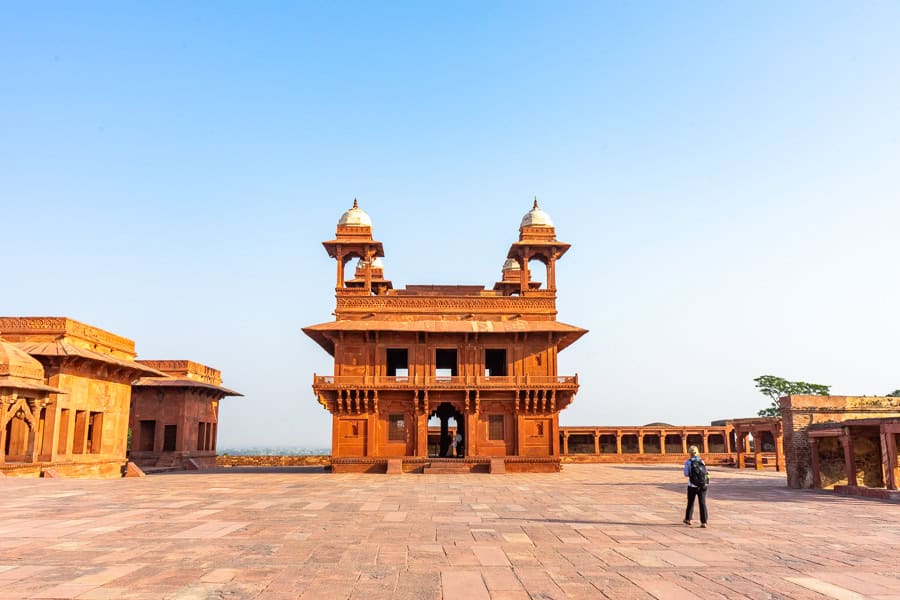
Final Leg (Option 2): Agra to Varanasi via Khajuraho
Highlights: Orchha Fort | Temples of Khajuraho | Varanasi
Total driving distance: appx. 820km (500 miles)
Total driving time: appx. 15 hours
Overnight: Orchha (1 night), Khajuraho (1 night) Varanasi (3 nights)
We’ll forgive you for needing a rest at this point. It’s been an epic journey and you might well feel the beaches and backwaters of southern India calling.
But if you have a little more petrol in your tank (both literally and figuratively), and another week or so up your sleeve, we can highly recommend continuing the journey from Agra to Varanasi.
It’ll take you a few days to travel the 800 or so kilometres to Varanasi, but fortunately the trip is broken up by a couple of offbeat stops.
The first is Orchha, a small (by Indian standards), 16th-century city with an opulent fort complex with temples, palaces and gardens. It’s around 5-6 hours from Agra and we spend a night here to break up the journey and explore the fort and town.
The next day we continue to the renowned, and slightly risqué, World Heritage site of Khajuraho. It’s a drive of nearly five hours from Orchha.
In Khajuraho, you’ll find three groups of thousand-year-old Hindu and Jain temples. The devil is in the detail here. Take the time to appreciate the exquisitely carved and highly detailed stonework on the temples, while keeping an eye out for the erotic sculptures that the site is famous for. We spent a night here too.
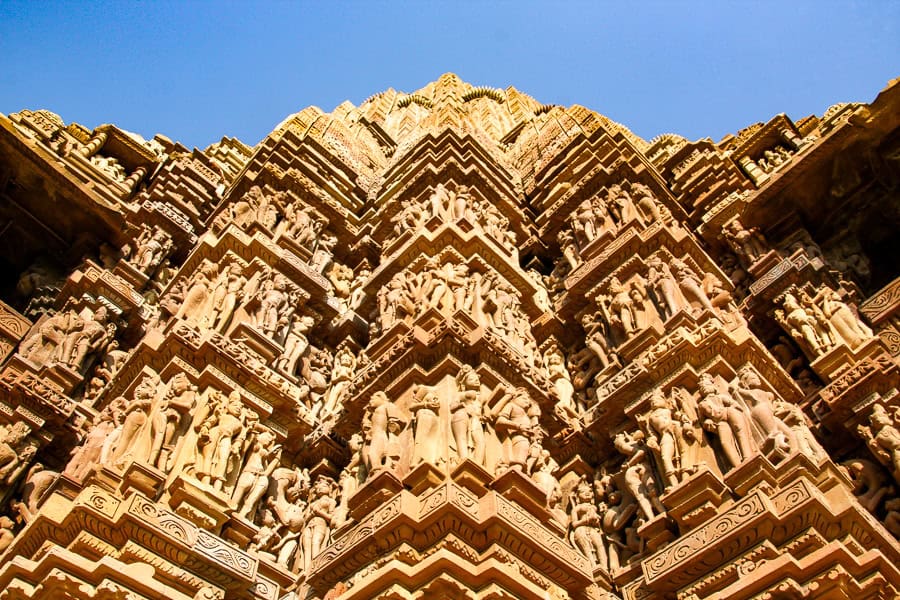
It takes most of a day to get to Varanasi, but when you do finally arrive, you’ll be rewarded with one of the most unique cities in India, if not the world.
Varanasi is a city to ponder. Sadhu ascetics colour the ghats with their orange garb and painted faces. The nightly Hindu Aarti ceremony brightens the riverbank of the Ganges with chant and flame. Hindu pilgrims from around the world make their way here to the river’s sacred ghats. For Hindu’s, this is the final stop before Nirvana and the most auspicious place in which to die.
Varanasi is a city to linger. It’s here, in this extraordinary, frenetic, eye-opening city, that we wrapped up a truly unforgettable journey through India’s north.
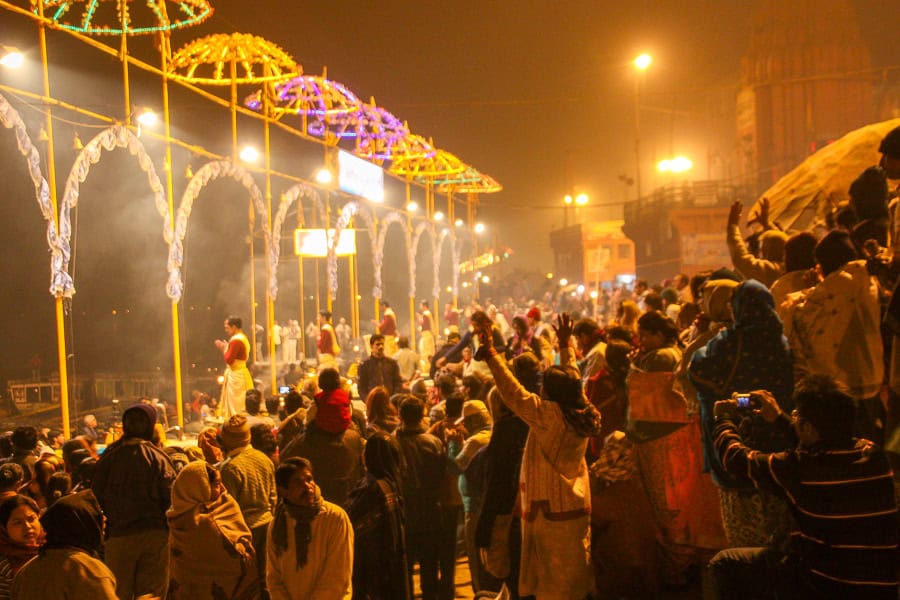
Where to stay in Varanasi
Varanasi has a huge range of accommodation options catering to different budgets and preferences. The areas around the ghats, particularly Assi Ghat, are particularly popular for their proximity to the river and the city’s main attractions.
We didn’t make a great choice with our stay here, so below are a few recommendations for places that get consistently decent reviews from others:
- Good value: Safarnama Varanasi B&B – Centrally located just a short walk from the ghats, this boutique B&B offers clean, spacious rooms with private bathrooms and air-con.
- Mid-range: Wander Station Varanasi – This popular, centrally located hostel just a short walk from the ghats has clean private rooms with air-con and a rooftop café with live music.
- Spend a bit more: Rana Mahal – A new boutique hotel set directly on the ghats, offering clean, spacious, well-maintained rooms with heritage features and views over the Ganges. The rooftop terrace serves breakfast with river views, and the hotel is within walking distance of the ghats.
Sound like your kind of adventure? If you’ve got any questions about our Rajasthan road trip or hiring a car and driver in India, ask us in the comments below.
If you’re looking for more great road tripping itineraries and adventures, check out our Road Trips page, and our bucket list of 100 ultimate road trips around the world.

Hi there!
You guys really had a fantastic journey!
Me and my girlfriend are going for 12 days in between april and may. It seems that the distances can be really impactful on the travel, could you please share the driver’s details? Many agencies are quite tricky 🙂
Thanks in Advance!
Lorenzo
Hi Lorenzo, many thanks for your comment and great to hear about your upcoming trip to India!
Time and distance are definitely big considerations when planning a Rajasthan road trip, perhaps the biggest! 🙂 We’ve sent you an email with the details of the company we used for a car and driver.
All the best and have a wonderful time!
Danielle & John
Hey guys, loved this write-up of your trip! We’re planning something similar for April 2025 and wondered whether you had any ideas for a two week itinerary rather than three weeks…also, please could you sghare your driver’s details?
Thanks
Mal
Hey Mal, thanks so much – we’re excited to hear you’re planning a trip to Rajasthan!
One of the biggest factors for planning a Rajasthan road trip is distance and drive time. While it does depend on personal interests, if we had two weeks, we would probably cut out the western desert and focus our time on the cities of Delhi, Jaipur, Jodhpur, Udaipur and Agra, with a couple of nights in each. This allows for travel time, with some sightseeing en route and a decent amount of time to explore each place without feeling rushed.
We’ve sent you an email with the car and driver details.
All the best with your planning and we hope you have a fantastic trip!
Wonderful road trip!
My wife and I we are planning something similar for next march, can you send me some more info about the driver?
Thanks a lot!
Hi Alessandro, many thanks for your lovely feedback, we hope you’ve found our post useful in your planning. We’ve sent you an email with further information about the car/driver company we used. All the best for your trip to India, have a wonderful time! Danielle & John
Wonderful trip report: thank you.
I wonder would you recommend driving between Jaisalmer and Jodhpur as the train trip is said to be remarkable.
We are headed there for 3 weeks in December and would appreciate your driver recommendations too.
To get most bang from the time away: One can fly to Varanasi & to Jaisalmer to cover those long distances then cobble together towns in Rajasthan by train or road.
Hi Jenny, many thanks for your feedback, we hope you found our Rajasthan road trip post useful! Train travel is a must at some point on any journey in India and we have some great memories of our own train travels in the country. While we haven’t done the Jaisalmer – Jodhpur leg by train, if your research is saying it’s a fantastic way to get between the two cities and you’re keen to do some train travel, then it’s worth considering. The drive from Jaisalmer to Jodhpur is around 4-5 hours (though I understand the train journey is a bit longer) but the upshot of going by road is that you can stop where you like, and with a driver, you still get to enjoy the scenery along the way. Absolutely you could cover some of those longer legs with flights (though I would note Jaisalmer can only be reached on a direct flight from Delhi or Jaipur in the north). I’ve sent you an email with some additional information. India is amazing, we hope you have a wonderful trip! Cheers, Danielle & John
Hey John & Danielle,
Inspiring – has me booking my road trip there now.
Will be basically following your route, with car/driver.
Any additional advice / insight will be appreciated.
Can’t wait.
Karl
Hi Karl, many thanks for your message! Very excited to hear you’ll be visiting Rajasthan – have a fantastic time!
This should be one of the epic road trip itinerary. Could you please share car and driver info.
Thanks for your kind comments.
Have sent you an email with some additional information.
All the best , John and Danielle
Hey John & Danielle,
What an amazing help this site is.
We are going oktober this year.
Can you send me more info regarding the driver as well please?
Thx a lot!
Kind regards,
Sofie & Jan
Hi there Sofie and Jan,
Thanks for your kind comments.
Have sent you an email with some additional information which we hope you’ll find useful.
Hope you have a fantastic trip.
All the best John and Danielle
Hi there!
This is such a great article, thanks so much for sharing. Please could you share your recommendations for a good driver/ company?
Thanks
Natalie
Hi there Natalie
Thanks for your kind comment, we’re so glad you found this post useful.
We’ve sent you an email with some additional information and hope you have a wonderful time in India.
All the best
John and Danielle
Hi,
Great article. I have just booked my flights and can’t wait to be there.
Did you have a car with a driver? If so do you have any recommendations for a good driver/ driver company
Thanks
Al
Hi there Al
Thanks for your kind comment, we’re so glad you found this post useful.
We’ve sent you an email with some additional information and hope you have a wonderful time in India.
All the best
John and Danielle
Great blog with such a fantastic route mapped out and generously shared.
We head to Rajasthan for 3 and a half weeks after flying from London to Mumbai (our return leg is back from Delhi).
We plan Mumbai, Jaipur, Bikaner, Jodhpur and Delhi with trips out to see as many temples and forts as possible (having been to Jaisalmer, Udaipur and Pushkar and Ossian previously.
We are giddy, like children, to be coming back – and first re-visit since the pandemic.
We’ve been 8 times previously but that said on this trip we plan to be more spontaneous and impromptu (with less structured plans) and keen therefore to find a reliable source of recommendations for drivers/car… if you have any, please!!!
Roll on March 24th… can’t wait!
Thanks again!
Warmest wishes,
Anthony
Hi there
Have sent you an email with some additional information.
Hope you and your friends have a wonderful time in India.
All the best
John and Danielle
Hello,
I am planning a trip to Rajasthan with 2 friends from the US. Did you use a car rental/driver/ guide? Can you please recommend what company you used? Thank you.
Hi there
Have sent you an email with some additional information.
Hope you and your friends have a wonderful time in India.
All the best
John and Danielle
Hi John an Danielle
This post is extremely helpful! We will be going to Northern India end of October for a month. First Bir and then we are planning to do a roadtrip in Rajasthan.
Would you mind to send me the email with additional information as well please.
Hi Hannelie
Have sent you an email with the additional info.
Regards
John and Danielle
Hi,
Fantastic write up and ideal for me as I am planning to get on my Jeep Compass and travel all overRajasthan, using your itinerary. A couple of questions:
1) When did you do this trip?
2) What were the road conditions?
3) is there any place you would drop out, if you were to do this again?
Cheers!
Shantanu
Hi Shantanu, really glad you found the itinerary helpful, we’re sure you will have an incredible trip.
We’ve done a few trips in Rajasthan over the years, most recently in 2018.
The roads were mostly ok, but can be poor in places, or be subject to construction work.
We loved the whole trip and wouldn’t want to miss any stops, however if you are time poor I guess Jaisalmer is quite far so you could save time there – although it’s a fabulous place to visit.
Happy travels
John and Danielle
Thank you for sharing about Rajasthan road trip
Thank you, glad you liked the post – can’t wait to come back!
Really very nice blog. Thanks for sharing this post with us.
Thank you , really glad you like the post.
Cheers
John and Dan
Totally liked your article as it is so brief that after few minutes you begin your virtual travel to Rajasthan, on top of that pictures shared doubles the experience.
Thank you
Thanks so much Madhuri, really glad you enjoyed the post.
All the best, John and Dan
You enjoyed trip of Rajasthan which place is best as you think?
Hi Shivraj
Hope you enjoyed the post. To be honest it’s almost impossible to have a favourite place on a trip that is so colourful, diverse, and full of incredible sights.
We loved the desert landscape and incredible fort at Jaisalmer, but to be honest the forts all over Rajasthan were stunning. Exploring Udaipur, especially the City Palace was a real treat, and there’s absolutely no compare to beautiful sights like the Taj Mahal, Fatehpur Sikri and the Red Fort in Delhi.
But honestly we loved absolutely all of it and would go back in a heartbeat.
Happy travels.
John and Dan
Awesome description. Please let me know how many days and nights for this kind of trip.
Hi Arup, really glad you enjoyed the post.
The trip duration really depends on your mode of travel, and how quickly you like to move. We had a car and driver and took three weeks, but you could easily double that if you wanted to spend longer in each place. Also, if you want to continue on to Varanasi (an additional 800 or so kilometres) via Orchha and Khajuraho you’d need to add another week.
All the best and happy travels.
John and Dan
When I visited Rajasthan with my family, none of us could bring ourselves to visit Karni Mata Temple. Even though we have heard a lot about this temple, it was just beyond us to visit a place filled with rats. It really is not for the squeamish. How did you manage to stay still there?
Hi there Pooja
You’re absolutely right, Karni Mata Temple is not for the squeamish. I’m really not quite sure how we managed it, the idea of all those rats did freak us out a little bit, but the experience is so unique, and the visit so memorable, I think we just somehow managed to push all the concerns away and enjoy the experience.
Would you ever go back and do it do you think?
All the best
John and Dan